Role of surface structure in heterogeneous nucleation
不同地区桃树根际土壤微生物群落结构及多样性分析

第44卷,第1期2024年1月栽培生理Cultivation Physiology中国果菜China Fruit &Vegetable不同地区桃树根际土壤微生物群落结构及多样性分析徐海忠2,薛彦华2,丁洪发2,戚恒瑞1,李天昊1,毛伟健1*,程凡升1*(1.青岛农业大学食品科学与工程学院,山东青岛266109;2.山东天同食品有限公司,山东临沂276000)摘要:植物根际土壤微生物群落能够加速根际营养元素的循环,调节土壤肥力。
分析桃树根际土壤微生态结构,可以为桃树种植土壤改良提供依据。
利用高通量测序技术对临沂市李官、汤头、沂水3个地区桃园根际土壤微生物多样性和群落组成进行分析。
经筛选和去除嵌合体后,得到了425267条优质序列,这些序列的长度主要集中在400~450bp 。
在3个地区的样品中共鉴定出4175个操作性分类单元(OTU )。
物种分类结果显示,细菌包括25个门、54个纲、145个目、272个科、497个属和577个物种。
在临沂不同地区的桃树根际土壤样品中,细菌群落组成和结构存在一定差异,细菌丰富度和多样性的顺序为汤头>沂水>李官。
细菌群落中,线菌门和变形菌门的丰度之和达到50.37%~66.07%,属于绝对优势菌门。
根据COG 功能分类统计,土壤细菌的功能基因主要集中在新陈代谢、遗传信息和细胞信号传导等方面。
总体而言,桃根际土壤的细菌多样性和群落组成在不同地区之间存在差异。
关键词:桃树;土壤;根际微生物;16S rRNA 测序中图分类号:TS201.3文献标志码:A文章编号:1008-1038(2024)01-0072-08DOI:10.19590/ki.1008-1038.2024.01.015Microbial Community Structure and Diversity of Peach RhizosphereSoil in Different RegionsXU Haizhong 2,XUE Yanhua 2,DING Hongfa 2,QI Hengrui 1,LI Tianhao 1,MAO Weijian 1*,CHENG Fansheng 1*(1.College of Food Science and Technology,Qingdao Agricultural University,Qingdao 266109,China;2.Shandong Tiantong Food Co.,Ltd.,Linyi 276000,China)Abstract:Plant rhizosphere soil microbial community can accelerate the circulation of rhizosphere nutrients andregulate soil fertility.The analysis of rhizosphere soil microecological structure of peach trees can effectively improve the planting soil of peach trees.The rhizosphere soil microbial diversity and community composition of收稿日期:2023-06-11基金项目:山东省重点研发计划-乡村振兴科技创新提振行动计划(2022TZXD0012);青岛特种食品研究院揭榜挂帅项目(6602422201)第一作者简介:徐海忠(1983—),男,工程师,本科,主要从事果蔬深加工方面的研究工作*通信作者简介:毛伟健(2000—),男,硕士,主要从事食品生物技术方面的研究工作程凡升(1983—),男,教授,博士,主要从事食品生物技术方面的教学与研究工作人类活动引起的全球变化包括大气二氧化碳浓度升高、气候变暖、降水变化、干旱和大气氮沉降增加,是全球范围内生物多样性丧失的主要因素[1]。
免疫学名词解释英
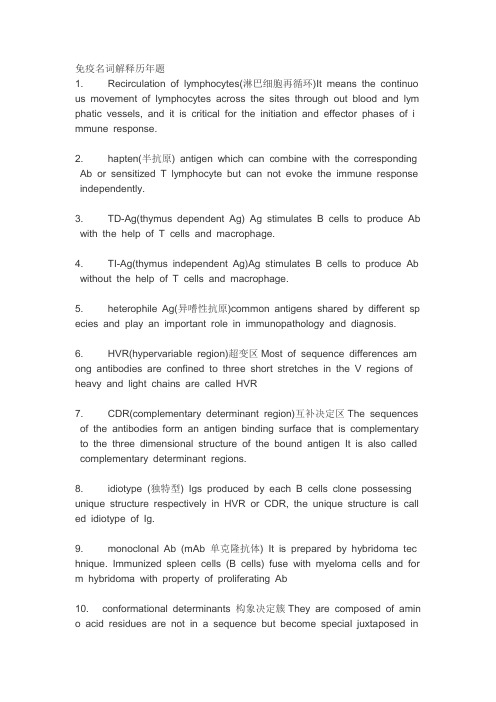
免疫名词解释历年题1. Recirculation of lymphocytes(淋巴细胞再循环)It means the continuo us movement of lymphocytes across the sites through out blood and lym phatic vessels, and it is critical for the initiation and effector phases of i mmune response.2. hapten(半抗原) antigen which can combine with the corresponding Ab or sensitized T lymphocyte but can not evoke the immune response independently.3. TD-Ag(thymus dependent Ag) Ag stimulates B cells to produce Ab with the help of T cells and macrophage.4. TI-Ag(thymus independent Ag)Ag stimulates B cells to produce Ab without the help of T cells and macrophage.5. heterophile Ag(异嗜性抗原)common antigens shared by different sp ecies and play an important role in immunopathology and diagnosis.6. HVR(hypervariable region)超变区Most of sequence differences am ong antibodies are confined to three short stretches in the V regions of heavy and light chains are called HVR7. CDR(complementary determinant region)互补决定区The sequences of the antibodies form an antigen binding surface that is complementary to the three dimensional structure of the bound antigen It is also called complementary determinant regions.8. idiotype (独特型) Igs produced by each B cells clone possessing unique structure respectively in HVR or CDR, the unique structure is call ed idiotype of Ig.9. monoclonal Ab (mAb 单克隆抗体) It is prepared by hybridoma tec hnique. Immunized spleen cells (B cells) fuse with myeloma cells and for m hybridoma with property of proliferating Ab10. conformational determinants 构象决定簇They are composed of amin o acid residues are not in a sequence but become special juxtaposed infolded protein. They are usually on the surface of antigen and be recog nized by B cells and Ab.11. ADCC(antibody dependent cell mediated cytotoxicity)It is a proce ss in which NK cells are target to Ab coated cells, resulting in lyses Ab coated cells .FcRⅢ is expressed on NK cell membrane and mediate b inding of IgG.12. MAC membrane attack complex 攻膜复合体A lytic complex of the terminal components of complement cascade, Including C5678and multico pies of C9,which forms in the membrane of target cells MAC causes let hal ionic and osmotic changes in cells.13. CK cytokine 细胞因子A group of low molecular weight polypeptides or proteins which are secreted by activated immunocytes or some matri x cells and possess high activity and various functions. Their major funct ions are to mediate and regulation immune response and inflammation r eaction.14. CAM or AM cell adhesion molecules 黏附分子The cell surface mol ecules whose function is to promote adhesive interaction with other cells or the extra cellular matrix and play a crucial role in cell interaction, re cognition, activation and migration.15. CD cluster of differentiation 分化簇It is a group of cell surface mol ecules associated with the development and differentiation of immune cel ls.16. MHC major histocompatibility complex主要组织相容性复合体It is a g roup of genes which encode for major histocompatibility antigens and rel ate to immune response.17. HLA human leukocyte antigen 人类白细胞抗原The major histocomp atibility antigens for human bodies which associated with histocompatibilit y and immune response.18. HLA complex The MHC of human, a cluster of genes which encode for HLA and related to histocompatibility and immune response.19. MHC restriction In interaction of T cell and APC or target cells, T cells not only recognize specific antigen but also recognize polymorphic r esidules of MHC molecules.20. PAMP(pathogen associated molecular pattern) 病原相关分子模式dist inct structures or components that are common for many pathogens ,such as LPS, dsRNA of viruses etc.21. PRR (pattern recognition receptor) The receptors that can recognize PAMP, located on the surface of macrophage, including mannose rece ptor, scavenger receptor , toll like receptor etc.22. APC a group of cells which can uptake and process antigen and p resent antigen-MHC-Ⅰ/Ⅱ complex to T cells, playing an important role in immune response.23. TCR complex a group of membrane molecules on T cells that can specifically bind to antigen and pass an activation signal into the cell, c onsisting of TCR(αβγδ),CD3 (γεδε)andζ-ζ。
碳质表面异相还原NO2 的反应机理

Received :2020⁃08⁃11;Revised :2020⁃09⁃26 *Corresponding author.Tel :188********,E⁃mail :923126537@. The project was supported by the National Natural Science Foundation of China (51976059).国家自然科学基金(51976059)资助碳质表面异相还原NO 2的反应机理许紫阳*,岳 爽,王春波,孙博昭,李航行(华北电力大学能源动力与机械工程学院,河北保定 071003)摘 要:基于量子化学密度泛函理论(DFT ),研究了碳质表面异相还原NO 2的反应机理,针对Zigzag 与Armchair 两种碳质表面,采用M 06⁃2X 方法与6⁃311G (d )基组联用,优化得到了不同反应路径下所有驻点的几何构型与能量,并对各路径进行了热力学与动力学分析,重点探究了CO 在NO 2异相还原反应中的作用规律,同时考察了碳质表面与反应温度对异相反应的影响㊂计算结果表明,NO 2在碳质表面的异相还原过程主要分为两个阶段,即NO 2还原阶段与碳氧化物释放阶段㊂通过对比无CO 分子参与的反应可知,参与反应的CO 分子可以降低各阶段的反应能垒并且加快各阶段的反应速率;CO 分子存在时,NO 2还原阶段的反应能垒被降低,促进了NO 2还原成NO 的异相反应过程,同时参与反应的CO 分子与碳质表面剩余氧原子结合,形成CO 2分子并释放,使碳氧化物释放阶段的反应能垒降低,从而促进了整体还原反应的进行㊂此外,与Armchair 型相比,基于Zigzag 型碳质表面的NO 2异相还原反应能垒更低且反应速率更快,说明NO 2异相还原反应更容易在Zigzag 型碳质表面进行㊂最后,由反应动力学分析可知,随着温度上升,各阶段的反应速率均增大,说明提高温度对碳质表面的NO 2异相还原能够起到促进作用㊂关键词:NO 2;CO ;碳质表面;异相还原;密度泛函;反应动力学中图分类号:TQ 534 文献标识码:AReaction mechanism of heterogeneous reduction of NO 2oncarbonaceous surfaceXU Zi⁃yang *,YUE Shuang ,WANG Chun⁃bo ,SUN Bo⁃zhao ,LI Hang⁃xing(School of Energy ,Power Engineering and Mechanical Engineering ,North China Electric Power University ,Baoding 071003,China )Abstract :Based on the quantum chemical density functional theory (DFT ),the mechanism of heterogeneous reduction of NO 2on carbonaceous surface was studied.For zigzag and armchair carbonaceous surfaces ,M 06⁃2X method and 6⁃311G (d )basis set were used to optimize the geometry configuration and energy of all stagnation points under different reaction paths ,and the reaction paths were analyzed and compared from thermodynamics and kinetics.The role of CO in the heterogeneous reduction of NO 2was deeply investigated ,and the effects of carbon surface and reaction temperature on the heterogeneous reaction were also investigated.The results show that the heterogeneous reduction process of NO 2on the carbon surface can be divided into two stages :the reduction stage of NO 2and the desorption stage of carbon oxide.By comparing the reactions without CO molecules ,it can be seen that the CO molecules involved in the reaction can reduce the reaction energy barrier of each stage and accelerate the reaction rate of each stage.In the presence of CO molecule ,the reaction energy barrier at the reduction stage of NO 2is reduced ,which promotes the heterogeneous reaction process of NO 2reduction to NO.CO molecules participating in the reaction can combine with the residual oxygen atoms on the surface to form and release CO 2molecules ,which reduces the reaction energy barrier in the release stage of carbon oxides ,thus promoting the overall reduction reaction.In addition ,the energy barrier of NO 2heterogeneous reduction reaction on zigzag surface is lower and the reaction rate is faster than that on armchair surface ,which indicates that the heterogeneous reduction reaction of NO 2is easier on Zigzag carbonaceous surface.Finally ,the reaction kinetics analysis shows that the reaction rate of each stage increases with the increase of temperature ,which indicates that increasing temperature can promote the heterogeneous reduction of NO 2on the carbonaceous surface.Key words :NO 2;CO ;carbonaceous surface ;heterogeneous reduction ;density functional theory ;reactionkinetics 氮氧化物NO x 是破坏自然环境和危害人体健康主要的大气污染物之一,大气中的NO x 污染物主第48卷第10期2020年10月燃 料 化 学 学 报Journal of Fuel Chemistry and Technology Vol.48No.10Oct.2020要来源于传统化石燃料的大量燃烧,包括燃煤产生的烟气与汽车排放的尾气[1-3]㊂研究指出,大气中的NO x气体污染物主要成分包括NO㊁N2O以及NO2等气体分子[4,5],目前,诸多学者重点关注了NO以及N2O的相关反应机理[6-10],而针对NO2的生成与还原机理研究报道较少㊂近年来,随着催化氧化技术以及富氧㊁流化床等燃烧技术的快速发展[11-13],使NO可以在较大温度范围内被氧化为NO2,导致大气环境中NO2气体污染物的增加㊂García等[14]的研究指出,与NO相比,NO2分子具有更低的键级键能与更高的偶极矩,其研究结果表明NO2分子有着更活泼的化学性质;同时,大量研究证实,大气中的NO2会引起人类呼吸道疾病并且造成酸雨㊁光化学烟雾等严重环境灾害[13,15]㊂因此,鉴于NO x尤其是NO2的严重危害性,探究如何减少煤炭燃烧与汽车尾气产生的NO2在大气中的排放尤为重要㊂当前,在各种控制NO2排放的方法中,碳质材料异相催化还原方法因具有价格低廉㊁吸附转化效率高㊁反应需要温度低等优点,在NO2吸附转化与化石燃料低氮控制方面具有良好的发展前景[16]㊂Juguirim等[17]通过固定床反应器研究了NO2在碳质表面的异相吸附与还原过程,结果表明,碳质表面不仅为NO2的吸附提供了反应位点,同时,碳质表面还对NO2异相还原为NO起到了催化作用; Muckenhuber等[18]通过TPD⁃MS实验同样证实,在100-900℃,NO2会在碳质表面发生异相还原反应,最终生成NO分子与C-(O)㊂上述实验结果均表明,碳质材料作不仅能够吸附NO2分子,同时可作为催化剂或还原剂,将NO2会异相还原为NO㊂此外,王春波等[19,20]的研究指出,高浓度CO气氛是影响NO2在碳质表面异相还原反应进行程度的重要因素,此结论同样被Wang等[4]的实验结果证实,后者利用一种固定床反应系统探究了富氧燃烧条件下NO2的异相还原特性,其实验结果表明,CO促进了碳质表面异相还原NO2的反应过程,并且随着CO组分浓度的增加,NO2还原率逐渐增加;另外,反应动力学数据亦表明,高浓度的CO降低了NO2异相还原反应的表观活化能,从而加速了反应的进行㊂上述实验研究不断深化了关于碳质表面NO2异相还原反应机理的认识,但由于碳质材料本身的复杂性以及反应的快速性[21],传统实验手段很难直接对碳质表面气体分子的反应历程进行直接测量,因此,关于碳质表面的NO2异相还原机理尚缺乏准确认知㊂近年来,随着计算机技术以及量子理论的发展,量子化学密度泛函计算(DFT)成为认识分子几何结构与探究反应机理的有效手段[22],采用量子化学密度泛函计算方法可以从分子层面详细揭示微观反应机理,同时便于进行反应动力学及热力学等相关参数的计算㊂Singla等[23]使用量子化学密度泛函方法,成功揭示了NO2在硼氮纳米管(BNNT)表面的异相吸附与转化机理㊂Zhu等[16]同样利用密度泛函理论方法,探究了纯碳质表面与氮掺杂碳质表面异相还原NO2的反应机理,从理论上揭示了碳质表面对NO2吸附与还原的影响规律,但该研究提出的路径只重点关注了NO2异相还原成NO过程,并未对后续碳氧化物释放过程进行研究,并且其反应体系中没有引入CO分子,并未揭示CO对NO2异相还原的影响规律㊂综上所述,目前,关于碳质表面NO2异相还原反应的微观机理研究报道较少,且CO分子对还原反应的作用机理也尚未明确㊂因此,本研究采用密度泛函方法(DFT),对NO2在碳质表面的异相还原反应机理进行分子层面理论研究,重点探究CO对NO2异相还原反应的作用规律,同时考察了碳质模型结构与反应温度对NO2异相还原反应的影响㊂计算得到NO2⁃CO异相还原反应路径中各驻点的几何优化构型与吉布斯自由能,同时从热力学与动力学角度对各路径的反应特性进行了详细对比,深入研究了纯碳质表面异相还原NO2的微观反应机理,为低氮控制技术提供一定的理论指导依据㊂1 计算理论1.1 模型选择研究发现,碳质材料主要是由多个芳香环型苯环组成[24],其中,锯齿(Zigzag)型和扶手(Armchair)型两种碳质表面模型可以较好地吻合实验观测结果,因此,被广泛应用于碳质材料表面的NO x反应机理研究中[25,26]㊂Jiao等[27]采用Zigzag 模型,研究了NO异相还原的反应机理,揭示了碳质表面N2㊁CO2等反应生成物的释放规律;余岳溪等[28]采用Armchair模型,成功得到了碳质表面异相还原N2O的微观反应机理㊂Chen等[29]和Yang 等[30]使用量子化学方法对Zigzag型和Armchair型两种模型的化学性质进行了计算,计算结果与实验结果较为吻合㊂Gao等[31]和Jiao等[32]均采用7321第10期许紫阳等:碳质表面异相还原NO2的反应机理 Zigzag 与Armchair 两种模型,对N 2O 与NO 异相还原反应机理进行了理论探讨㊂综上,为深入研究碳质表面NO 2异相还原反应机理,本文选取Zigzag 型与Armchair 型两种结构作为碳质表面计算模型,模型结构见图1㊂图1 碳质表面模型示意图Figure 1 Framework of carbonaceous surface model1.2 计算方法研究表明,采用M 06⁃2X 方法可以在自旋污染较小的情况下提高反应能垒的准确度[33],并且此方法可以较准确地描述分子间非共价相互作用力,因而被广泛应用于较大分子体系的计算中[34]㊂本研究中,采用M 06⁃2X 方法与6⁃311G (d )基组联用[27]对各势能面上的几何结构进行优化,得到反应物(P )㊁产物(R )㊁各中间体(IM )及过渡态(TS )的几何构型;同时在M 06⁃2X /6⁃311G (d )水平上进行单点能计算,并引入零点能校正㊂此外通过振动频率分析几何结构的性质,中间体无虚频,过渡态有且仅有一个虚频;并对虚频结构进行了内禀坐标计算(IRC ),以保证各过渡态结构与反应物㊁中间体和产物之间的正确连接[35]㊂本研究所有计算均由Gaussian 16程序完成[36]㊂采用经典过渡态理论(TST )得到各反应动力学参数,计算公式如下[37]:k =Γ×k B T h ×Q TS Q A ×Q B ×exp (-Ea R ×T )(1)Γ=1+(124)×(h υm c k B T)2(2)式中,Γ为量子隧道修正系数;E a 为反应能垒,kJ /mol ;R 为气体摩尔常数,J /(mol ㊃K );T 为温度,K ;k B 为玻尔兹曼常数,J /k ;h 为普拉克常数,J ㊃s ;Q TS ㊁Q A ㊁Q B 依次为过渡态TS ㊁反应物A 与反应物B 的配分函数;υm 为反应路径振动的频率;cm -1;c 为光速,单位为m /s ㊂2 结果与讨论本节中,分别讨论了NO 2在Zigzag 与Armchair型两种碳质表面的异相还原反应过程㊂首先,分析了NO 2在碳质表面的吸附过程,并比较了不同构型的吸附能,从而选择出各自路径中热力学上最有利的初始反应物构型;其次,根据反应路径计算结果,将整个异相还原过程分成两个阶段,分别为NO 2还原与碳氧化物释放阶段;同时,通过对比有无CO 参与的反应路径,探讨了CO 对NO 2异相还原反应中各阶段的影响规律㊂2.1 Zigzag 型碳质表面NO 2异相反应2.1.1 Zigzag 型碳质表面NO 2吸附构型在碳质表面进行的异相反应均以反应物的化学或物理吸附作为反应的第一步[38],本研究中,NO 2在碳质表面的吸附是整个反应路径的第一步㊂由于Zigzag 与Armchair 碳质模型表面的不同碳位点常常表现出不同的反应活性[39,40],因此,首先对NO 2在碳质表面所有可能的吸附构型进行了计算㊂吸附构型与能量变化见图2㊂图2 NO 2吸附构型与能量Figure 2 Adsorption configuration and energy of NO 2由图2可知,NO 2能够以N⁃O⁃down 和O⁃O⁃down 两种方式吸附在Zigzag 型碳质表面不同活性C 位点上,最终形成五种不同构型㊂由能量变化可知,当NO 2以O⁃O⁃down 的方式吸附在Zigzag 型碳质表面的侧边界上放出的能量最多,也就是说,在同等热力学条件下,吸附构型Z 1最易形成㊂因此,本研究在关于Zigzag 型碳质表面进行的反应路径研究中,均采用吸附构型Z 1作为反应的起始反应物㊂2.1.2 CO 参与下Zigzag 型碳质表面NO 2异相还原(路径1)CO 参与时Zigzag 型碳质表面NO 2异相还原的反应过程与能量变化见图3,反应路径中涉及的各驻点结构见图4㊂为便于描述,将此路径称为路径1㊂8321 燃 料 化 学 学 报第48卷图3 路径1反应过程的能量变化Figure 3 Potential energy surface change of path⁃1图4 路径1反应过程的各驻点结构Figure 4 Structures of stagnation points of path⁃1 由图3㊁图4可知,路径1的反应经历五个过渡态和六个中间体,最终生成一个NO 分子和一个CO 2分子㊂为清楚描述整体反应过程,根据反应顺序,可将IM 1⁃IM 4过程定义为NO 2还原阶段,将IM 5⁃P 过程定义为碳氧化物释放阶段㊂其中,NO 2还原阶段的反应过程描述如下:首先,CO 分子以C⁃down 方式吸附在C (3)位点形成IM 1,并释放出393.3kJ /mol 的能量,较自由状态下已经趋向于分离;随后,此N -O 键继续被拉长直至断裂,同时C (2)位点上的O 原子与C (3)位点上的C 原子靠近并成键,形成CO 2分子,此过程翻越的能垒为52.5kJ /mol ;紧接着,C (1)位点上的NO 分子克服9321第10期许紫阳等:碳质表面异相还原NO 2的反应机理10.7kJ /mol 的能垒旋转形成结构IM 3;最终,吸附在C (1)位点上的NO 分子克服108.7kJ /mol 的反应能垒脱离碳质表面,脱离过程中C (1)-O 键长变化为1.387Å(IM 3)→1.948Å(TS 3)→∞Å(IM 4),同时,NO 分子的N -O 键长由1.310Å缩短至1.139Å,与自由气体状态下N -O 键长一致,实现NO 分子从碳质表面的完全脱附㊂此时,NO 2分子经碳质表面异相吸附与分解已被还原为NO 分子,对比上述反应过程的能量变化可知,由IM 3→IM 4的反应过程能垒最大,表明路径1中NO 2还原阶段的决速步为NO 释放过程㊂NO 2还原过程中CO 分子已经吸附在Zigzag表面,因此,NO 2还原成NO 并释放后,剩余的O 原子与CO 分子结合形成CO 2分子,此时路径1中碳氧化物释放阶段表现为CO 2分子释放过程,反应过程描述如下:首先,IM 5中C (3)-C 键发生断裂并克服217.7kJ /mol 的反应能垒形成IM 6,C (3)-C 键长由1.473Å被拉长为3.096Å;随后,C (2)位点上的O 原子克服84.1kJ /mol 的反应能垒脱离碳质表面,C (2)-O 键由1.401Å增大为2.934Å,同时,CO 2分子中C -O -C 键角由130.6°增大为180.0°,与自由气体状态下一致,从而实现CO 2分子的完全脱附㊂对比反应过程中的能量变化可知,路径1中碳氧化物释放过程的决速步为IM 5→IM 6㊂2.1.3 Zigzag 型碳质表面NO 2异相还原(路径2)无CO 参与时NO 2异相还原的反应过程与能量变化见图5,反应路径中涉及的各驻点结构见图6㊂为便于描述,将此路径称为路径2㊂图5 路径2反应过程的能量变化Figure 5 Potential energy surface change of path⁃2 结合图5㊁图6可以看出,无CO 参与时,路径2同样可分为NO 2还原阶段与碳氧化物释放阶段,分别为过程IM 1⁃IM 4与IM 5⁃P 1㊂其中,NO 2还原过程共经历三个过渡态与四个中间体,最终生成一个NO 分子与一个O 原子吸附在碳质表面,此阶段反应过程描述如下:首先,吸附在碳质表面上的NO 2分子中N -O 键克服58.4kJ /mol 的能垒由1.378Å被拉长为2.679Å,NO 2分解为NO 分子与O 原子;随后,NO 分子克服2.9kJ /mol 的反应能垒绕C (1)位点上的O 原子旋转形成结构IM 3;最后,吸附在C (1)位点上的NO 分子克服116kJ /mol 的反应能垒脱离碳质表面,脱离过程中C (1)-O 键长变化为1.380Å(IM 3)→1.945Å(TS 3)→∞Å(IM 4)㊂对比各反应过程的能量变化可知,路径2中NO 2还原过程的决速步同样为IM 3→IM 4,即NO 释放过程㊂此外,由路径2与路径1中NO 2还原过程的决速步能垒值变化可知,路径1中NO 2异相还原过程能垒更低,这表明,CO 分子的参与使Zigzag 型碳质表面NO 2还原阶段的反应能垒被降低,CO 分子对NO 2异相还原反应存在促进作用㊂由路径2反应过程可以看出,无CO 分子参与时,NO 2还原阶段形成的O 原子直接与碳质表面C 原子结合形成CO 分子后脱离碳质表面㊂此反应过程具体描述如下:首先,碳质表面上C (2)活性位点所属的六元环断裂;随后,断裂形成的CO 分子克服430.8kJ /mol 的反应能垒从碳质表面脱离;最后原C (2)位点所属六元环封闭形成五元环,形成如P 1所示的稳定结构㊂此时CO 分子中C -O 键长变为1.123Å,与自由气体状态下一致,可以看到当CO 分子未参与时,碳氧化物释放阶段只经历一个过渡态,形成一个NO 分子与一个CO 分子㊂对比路径1与路径2的反应过程可以看出,CO 分子参与反应时会与NO 2还原后的剩余O 原子结合形成CO 2分子后再脱离碳质表面,使路径1中碳氧化物释放阶0421 燃 料 化 学 学 报第48卷段的反应能垒降低㊂以上分析表明,在Zigzag 型碳质表面异相还原NO 2的反应中,CO 分子不仅对NO 2还原过程存在促进作用,同时,作为反应物的CO 分子使碳氧化物释放过程变得容易,从而促进了整体反应的进行㊂图6 路径2反应过程的各驻点结构Figure 6 Structures of stagnation points of path⁃22.2 Armchair 型碳质表面NO 2异相还原2.2.1 Armchair 型碳质表面NO 2吸附构型为探究碳质表面的结构对NO 2异相还原反应的影响㊂同Zigzag 型碳质模型一致,首先对NO 2在Armchair 型碳质表面的不同吸附构型进行了能量计算与比较,吸附构型与能量见图7㊂由图7可以看到,NO 2分别能够以N⁃O⁃down 和O⁃O⁃down 两种方式吸附在Armchair 型碳质表面不同活性位点上,形成六种不同吸附构型㊂由能量变化可知,吸附结构A 1的能量最低,这表明在同等热力学条件下,结构A 1最容易形成㊂因此,本研究在关于Armchair 型碳质表面进行的反应路径研究中,采用吸附构型A 1作为反应的起始反应物㊂值得注意的是,当NO 2吸附在Armchair 型碳质表面形成A 1结构时,分子中的一个N -O 键即发生断裂,此时吸附在碳质表面的NO 2已经分解为C (NO )与C (O)㊂图7 NO 2吸附构型与能量Figure 7 Adsorption configuration and energy of NO 21421第10期许紫阳等:碳质表面异相还原NO 2的反应机理2.2.2 CO 参与下Armchair 型碳质表面NO 2异相还原(路径3)CO 参与时Armchair 型碳质表面NO 2异相还原过程和碳氧化物释放过程的能量变化见图8㊂反应中涉及的各驻点结构见图9㊂为便于描述,将此路径称为路径3㊂图8 路径3反应过程的能量变化Figure 8 Potential energy surface change of path⁃3图9 路径3反应过程的各驻点结构Figure 9 Structures of stagnation points of path⁃3 由图8与图9可以看到,路径3的反应共经历四个过渡态和五个中间体,最终形成成一个NO 分子与一个CO 2分子㊂同样根据反应顺序,将反应中IM 1⁃IM 2过程定义为NO 2还原阶段,IM 3⁃P 过程定2421 燃 料 化 学 学 报第48卷义为碳氧化物释放阶段㊂各阶段反应过程描述如下:首先,游离CO 分子以C⁃O⁃down 的形式吸附在Armchair 碳质表面的C (3)和C (2)活性位点形成IM 1;随后,C (1)位点上NO 分子克服134.5kJ /mol 的反应能垒脱离碳质表面;最后,剩余在碳质表面的CO 2分子经历三个过渡态脱离碳质表面:第一,C (3)位点上的C 原子克服112.2kJ /mol 的反应能垒发生脱离,C (3)⁃C 键由1.464Å被拉长为2.893Å,同时C -O -C 键角由118.2°增大为126.0°;第二,C (2)位点上的CO 2分子克服34.9kJ /mol 的反应能垒绕C (2)⁃O 原子发生翻转形成结构IM 5;第三,C (2)位点上的O 原子翻越105.2kJ /mol 的能垒脱离碳质表面,C -O -C 键角由130.1°变为180.0°,同时C -O 键长由1.399Å变为1.155Å,与自由气体状态下一致,最终实现CO 2的完全脱附㊂从反应能量变化可以看出,路径3中NO 2还原阶段的决速步为IM 1→IM 2,碳氧化物释放过程的决速步反应为IM 3→IM 4㊂对比路径1与路径3中NO 2还原阶段的反应过程可以发现,Zigzag 型与Armchair 型碳质表面NO 2还原阶段的决速步均为NO 释放过程,由能垒变化可知,路径1中NO 释放所需的反应能垒较路径3更低,这表明与Armchair 型碳质相比,Zigzag 型碳质表面的NO 2还原反应更容易发生,说明Zigzag 型碳质表面对NO 异相还原反应的促进作用较强㊂2.2.3 Armchair 型碳质表面NO 2异相还原(路径4)无CO 参与时Armchair 型碳质表面NO 2异相还原过程和碳氧化物释放过程的能量变化见图10,反应中涉及的各驻点结构见图11㊂为便于描述,将此路径称为路径4㊂同路径3中NO 2还原阶段的过程类似,由于吸附后NO 2分子中一个N -O 键已经发生断裂,路径4中NO 2还原阶段反应过程同样为NO 分子的释放过程,即IM 1→IM 2㊂由反应路径的能量变化可知,路径4中NO 分子释放过程所克服的反应能垒为151.6kJ /mol ,与路径3相比,路径4中NO 2还原所克服的反应能垒较高,以上分析进一步说明,CO 分子对NO 2还原阶段的反应存在促进作用㊂同时,对比路径4与路径2中NO 2还原阶段的反应能垒可以发现,路径2的决速步能垒更低,这进一步表明与Armchair 相比,在Zigzag 型碳质表面进行的NO 2异相还原反应更容易发生㊂同样根据反应顺序,将路径4中过程IM 3⁃P 定义为碳氧化物释放过程,反应共经历三个过渡态与三个中间体,最终形成一个CO 分子脱离碳质表面㊂反应过程描述如下:首先,结构IM 3中C (1)原子与C (5)原子克服92.1kJ /mol 的反应能垒靠近成键;其次,C (1)位点上的CO 分子克服10.7kJ /mol 的反应能垒绕C (2)原子旋转形成IM 5;最后,C (1)位点上的CO 分子克服131.1kJ /mol 的反应能垒脱离碳质表面,脱离过程中C (1)-C (2)键长变化为1.460Å(IM 5)→2.277Å(TS 4)→3.091Å(P ),同时脱离后CO 分子的C -O 键长变为1.123Å,最终与自由气体状态下一致,从而实现CO 分子从碳质表面的完全脱离,由上述能量变化可知,碳氧化物释放阶段的决速步为IM 5→P㊂图10 路径4反应过程的能量变化Figure 10 Potential energy surface change of path⁃42.3 反应动力学分析根据经典过渡态理论,计算各反应路径决速步在300-900K [2,18]反应速率常数,其中,图12(a )为各反应路径中NO 2还原阶段决速步的反应速率常3421第10期许紫阳等:碳质表面异相还原NO 2的反应机理数,图12(b )为各反应路径碳氧化物释放阶段决速步的反应速率常数㊂同时对各反应速率常数曲线拟合得到各反应的动力学参数,结果见表1㊂图11 路径4反应过程的各驻点结构Figure 11 Structures of stagnation points of path⁃4图12 (a )NO 2分解阶段决速步反应速率常数,(b )碳氧化物释放阶段决速步反应速率常数Figure 12 (a )Reaction rate constants of the rate⁃determining steps in the reduction of NO 2,(b )Reaction rate constants of therate⁃determining steps in the desorption of carbon oxide 由图12(a )与图12(b )可知,随着温度的上升,各反应的速率常数均增大,说明提高温度对NO 2异相还原起到促进作用;同时通过对比无CO分子参与的各阶段反应过程可以发现,CO 分子参4421 燃 料 化 学 学 报第48卷与时各阶段的反应速率常数均大于无CO 分子参与时的反应速率常数,这说明CO 分子对碳质表面异相NO 2的反应存在促进作用㊂表1 反应动力学参数Table 1 Reaction kinetic parametersModels StagesPre⁃exponential factor A /s -1Activation energy E a /(kJ ㊃mol -1)Arrhenius equation ZigzagNO 2reduction with CO2.90×1013104.01k =2.90×1013e -12508.41/T NO 2reduction without CO 1.40×1014124.25k =1.40×1014e -14943.92/T carbon oxide desorption with CO9.49×1013224.42k =9.49×1013e -26991.54/T carbon oxide desorption without CO5.44×1016454.69k =5.44×1016e -54686.77/T ArmchairNO 2reduction with CO 3.54×1014135.00k =3.54×1014e -16236.87/T NO 2reduction without CO9.03×1014164.55k =9.03×1014e -19790.39/T carbon oxide desorption with CO 3.94×1013116.58k =3.94×1013e -14021.60/T carbon oxide desorption without CO3.58×1015127.59k =3.58×1015e -15345.05/T 由表1可知,CO 分子参与时各路径中NO 2还原阶段的反应活化能均小于无CO 分子参与时的反应活化能,这表明CO 分子参与反应时,NO 2异相还原过程更容易发生,CO 分子对NO 2异相还原存在促进作用;另外对比各路径中碳氧化物释放阶段的反应活化能可以发现,与无CO 分子相比,CO 分子参与反应时碳质表面碳氧化物释放阶段的反应活化能均更低,说明CO 分子同样促进了碳氧化物释放反应的进行㊂以上分析结果同王鹏乾等[19,41]的实验现象基本一致,后者利用固定床反应平台研究了富氧燃烧条件下NO 2的异相还原特性,实验结果表明提高反应温度㊁CO 分子参与均对碳质表面的NO 2异相还原存在促进作用㊂另外,对比NO 2在不同碳质表面还原阶段的反应活化能与反应速率常数可以发现,在Zigzag 型碳质表面进行的NO 2还原反应的活化能更低且速率常数更大,这表明与Armchair 型相比,NO 2还原反应更容易在Zigzag 表面进行且反应速率常数更快,说明Zigzag 型碳质表面的催化活性更高,这与Gao[31,32,40]等的理论计算结论一致㊂3 结 论碳质表面异相还原NO 2的反应过程可以分为两个阶段:NO 2还原阶段与碳氧化物释放阶段㊂其中,NO 2还原阶段的反应生成一个NO 分子,同时在碳质表面剩余一个O 原子;根据有无CO 分子参与反应,碳氧化物释放阶段的反应分别生成一个CO 2分子与一个CO 分子从碳质表面释放㊂参与反应的CO 分子可以降低各阶段的反应能垒并且加快各阶段的反应速率,对碳质表面异相还原NO 2的反应存在促进作用㊂在NO 2还原阶段,CO 分子的参与NO 2异相还原为NO 的反应能垒降低,加快了NO 2异相还原的反应速率;在碳氧化物释放阶段,参与反应的CO 分子与剩余O 原子结合形成CO 2后从碳质表面释放,降低了反应能垒,从而促进了整体反应的进行㊂与Armchair 型相比,在Zigzag 型碳质表面进行的NO 2异相还原反应能垒更低且反应速率常数更大,这表明NO 2异相还原成NO 的反应更容易在Zigzag 型碳质表面进行㊂随着温度的上升,各阶段的反应速率常数均增大,说明提高温度对碳质表面异相还原NO 2反应存在促进作用㊂参考文献[1] 张秀霞,吕晓雪,伍慧喜,谢苗,林日亿,周志军.钠对焦炭非均相还原NO 的微观作用机理[J ].燃料化学学报,2020,48(6):663-673.(ZHANG Xiu⁃xia ,LÜXiao⁃xue ,WU Hui⁃xi ,XIE Miao ,LIN Ri⁃yi ,ZHOU Zhi⁃jun.Microscopic mechanism for effect of sodium on NO heterogeneous reduction by char [J ].J Fuel Chem Technol ,2020,48(6):663-673.)[2] 谈冠希,迟姚玲,李双,易玉峰,靳广洲.锰锆复合氧化物CO 催化还原NO 性能研究[J ].燃料化学学报,2019,47(10):1258-1264.(TAN Guan⁃xi ,CHI Yao⁃ling ,LI Shuang ,YI Yu⁃feng ,JIN Guang⁃zhou .Study on the performance of Mn⁃Zr composite oxide for CO reduction of NO [J ].J Fuel Chem Technol ,2019,47(10):1258-1264.)[3] TAYLOR K.nitric oxide catalysis in automotive exhaust systems [J ].Catal Rev ,1993,4(35):457-481.[4] WANG C ,WANG P ,DU Y ,CHE D.Experimental study on effects of combustion atmosphere and coal char on NO 2reduction under oxy⁃fuelcondition [J ].J Energy Ins ,2019,92(4):1023-1033.[5] 信晶.煤焦⁃NO 反应过程中氮转化机理与试验研究[D ].北京:华北电力大学,2015.5421第10期许紫阳等:碳质表面异相还原NO 2的反应机理。
中英文催化剂的制备与表征(catalysis and physical properties)

Introduction to this subject
➢ Preparation, characterization and application of a catalyst is crucial to innovate a novel catalyst.是发明一个新催化剂的关键。
➢ Catalyst is usually not the same with other chemicals, especially pure chemicals.催化剂一般与其他化学品一样,特别是纯化学品。
Definition of Catalyst
➢ Ostwald (德国)的观点 催化剂是一种能够改变化学反应的速度,而它本身又不 参与最终产物的 物质。 (流行)
➢ IUPAC定义: 催化剂能够加速反应速率而不改变反应的标准Gibbs自 有焓变化。
➢ 国内新近定义 催化时加速反应速度、控制反应方向或产物构成,而不 影响化学平衡的一类作用。起这种作用的物质称为催化 剂,它不在主反应的化 学计量式中反映出来,即在反应 中不被消耗。
Ideal surface is not perfect
理想的表面是不完美的
扭结
阶梯空位
阶梯位
台阶吸附的原子 台阶空位
球的堆积模型表示不完美表面
Heterogeneous Catalyst
* Metals (Transition metals, IB metals);金属
Fe Co Ni Ru Rh Cu Ag Au Pd Os Ir Pt
Mechanism for heterogeneous Catalysis
Heterogeneous Catalysis
➢ Heterogeneous mechanism is difficult to investigated in the laboratory. Disappearance of reactants and appearance of products are easily followed, but important features such as the rates and energetic of adsorption, structure of active sites, the nature of active intermediates, require separate experimentation using a constantly changing arsenal of techniques. 非均相机理的实验室研究非常困难。反应物的消耗和产物的生成比 较容易追踪,但许多重要的因素比如速度和吸附能,活性位结构、 活性中间体特点等需要通过大量的单因素实验来得出。
仿生表面结构设计对液滴冷凝及收集行为的影响

第52卷第8期表面技术2023年8月SURFACE TECHNOLOGY·355·仿生表面结构设计对液滴冷凝及收集行为的影响周鹏1,胡建华1,李蓓1,2(1.武汉理工大学 材料科学与工程学院,武汉 430070;2.华中科技大学 材料成形与模具技术国家重点实验室,武汉 430070)摘要:目的提高仿生表面液滴冷凝及收集效率。
方法借鉴典型生物微纳结构及表面特性,采用分子动力学方法,建立水汽冷凝演化模型,分析纳米阵列形貌、亲疏水比及楔形顶角对液滴冷凝及收集行为的影响。
结果液滴在方形阵列结构中易钉扎,不利于去除;在矩形阵列结构中具有较好的流动性,且相对方形阵列表面凝结量提升了30.8%。
随着亲疏水比θ的增加,沉积在阵列间隙的水分子数增多,钉扎效应加剧,更易形成膜状冷凝;相反地,θ越小,液滴倾向形成滴状冷凝并呈现Cassie态。
调整楔形阵列的顶角α可以有效实现液滴的定向运动。
当α为3°或6°时,楔形结构能够产生足够的Laplace压力差,驱使液滴定向运动;当α为9°或12°时,能够引导液滴在楔形结构尾端聚集,并融合成更大尺寸的液滴,凝结量相对α为0°分别提升了210.7%和193.0%,收集效率显著提高。
相比于单一的仿生表面,结合沙漠甲虫和仙人掌的耦合集水策略设计出的双重仿生结构在凝结量及最大液滴尺寸上均有明显提升,有效提高了液滴的冷凝及收集效率。
结论通过调节纳米阵列形貌和楔形顶角,并合理设置亲疏水比,可有效提高液滴冷凝及收集效率。
研究结果为强化冷凝功能的仿生表面设计提供了一定的理论指导。
关键词:仿生表面;纳米阵列;亲疏水比;楔形顶角;冷凝;定向运动;分子动力学模拟中图分类号:TG147 文献标识码:A 文章编号:1001-3660(2023)08-0355-08DOI:10.16490/ki.issn.1001-3660.2023.08.030Effect of Bio-inspired Surface Structure Design on DropletCondensation and Harvesting BehaviorZHOU Peng1, HU Jian-hua1, LI Bei1,2(1. School of Materials Science and Engineering, Wuhan University of Technology, Wuhan 430070, China;2. State Key Laboratory of Materials Processing and Die & Mould Technology, Huazhong Universityof Science and Technology, Wuhan 430070, China)ABSTRACT: Bio-inspired water harvesting surfaces present superb self-cleaning and self-propelling properties, high efficiency,收稿日期:2022-07-22;修订日期:2022-11-22Received:2022-07-22;Revised:2022-11-22基金项目:华中科技大学材料成形与模具技术国家重点实验室开放课题研究基金(P2021-009)Fund:Open Fund Project of State Key Laboratory of Materials Processing and Die & Mould Technology, Huazhong University of Science and Technology (No. P2021-009)作者简介:周鹏,(1996—),男,硕士研究生,主攻仿生表面结构设计及其液滴收集计算模拟。
医学免疫学名解英文综述
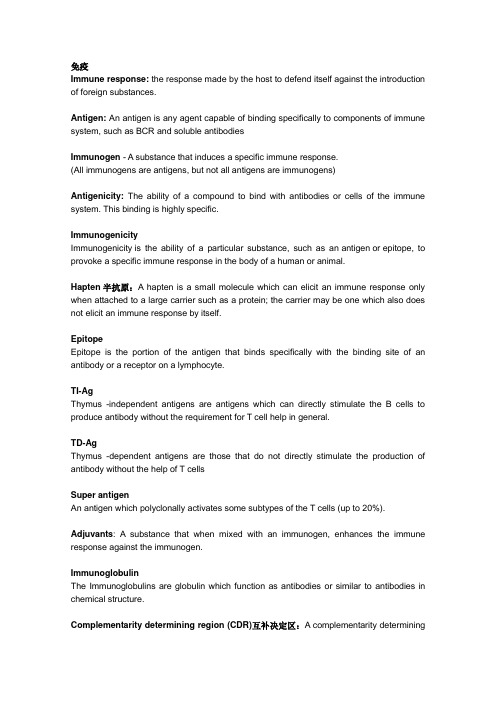
免疫Immune response: the response made by the host to defend itself against the introduction of foreign substances.Antigen: An antigen is any agent capable of binding specifically to components of immune system, such as BCR and soluble antibodiesImmunogen - A substance that induces a specific immune response.(All immunogens are antigens, but not all antigens are immunogens)Antigenicity: The ability of a compound to bind with antibodies or cells of the immune system. This binding is highly specific.ImmunogenicityImmunogenicity is the ability of a particular substance, such as an antigen or epitope, to provoke a specific immune response in the body of a human or animal.Hapten半抗原:A hapten is a small molecule which can elicit an immune response only when attached to a large carrier such as a protein; the carrier may be one which also does not elicit an immune response by itself.EpitopeEpitope is the portion of the antigen that binds specifically with the binding site of an antibody or a receptor on a lymphocyte.TI-AgThymus -independent antigens are antigens which can directly stimulate the B cells to produce antibody without the requirement for T cell help in general.TD-AgThymus -dependent antigens are those that do not directly stimulate the production of antibody without the help of T cellsSuper antigenAn antigen which polyclonally activates some subtypes of the T cells (up to 20%).Adjuvants:A substance that when mixed with an immunogen, enhances the immune response against the immunogen.ImmunoglobulinThe Immunoglobulins are globulin which function as antibodies or similar to antibodies in chemical structure.Complementarity determining region (CDR)互补决定区:A complementarity determiningregion (CDR) is a short amino acid sequence found in the variable domains of antigen receptor (e.g. immunoglobulin and T cell receptor) proteins that complements an antigen and therefore provides the receptor with its specificity for that particular antigen.Complement:A group of serum proteins involved in the control of inflammation, the activation of phagocytes and the lytic attack on cell membranes. It belongs to the innate immune system, and can be recruited and brought into action by the adaptive immune system.Common receptor subunitThere is same receptor subunit for cytokine signaling among the different cytokine receptors.e.g. common γ chainCytokine (CK) : Small soluble proteins that mediate immune and inflammatory reactions and are responsible for communications between leukocytes and other cells.Soluble cytokine receptorSoluble cytokine receptor is the extracellular part of the receptor, which can competitively bind to cytokineCytokine storm: Under certain circumstances (e.g. septic shock), large amounts of CKs (such as TNF) are produced, they may be active distant from their site of secretion.Leukocyte differentiation antigen白细胞分化抗原:The cell surface markers which express or disappear on the different cells in the different stages of differentitation and activation.Cluster of differentiation (CD): Cell surface molecules of leucocytes that are distinguishable with monoclonal antibodies as an immunologic marker.Cell adhesion molecules, CAM: A group of proteins involved in adhesion of cell to cell or cell to extracellular matrix (ECM), such as ICAM-1, ICAM-2, ICAM-3, VCAM-1 and PECAM etc.IntegrinIntegrins are transmembrane receptors that mediate the attachment between a cell and the tissues that surround it, such as other cells or the extracellular matrix (ECM)SelectinsSelectins (CD62) are a family of cell adhesion molecules.MHC主要组织相容性复合物:The major histocompatibility complex (MHC) is a large genomic region or gene family found in most vertebrates. It is the most gene-dense region of the mammalian genome and plays an important role in the immune system, autoimmunity, and reproductive success.PolymorphismThe phenomenon of having multiple alleles at given genetic locus in the populationSomatic hypermutation体细胞高度突变:Somatic hypermutation (or SHM) is a mechanism inside cells that is part of the way the immune system adapts to the new foreign elements which confront it (for example, microbes).ITAMAn immunoreceptor tyrosine-based activation motif (ITAM) is a conserved sequence of four amino acids that is repeated twice in the cytoplasmic tails of certain cell surface proteins of the immune system.Negative selection负选择:The death of autoimmune lymphocytes shortly after they develop. Also known as clonal deletion.Positive selection: Double positive cells that bind, with moderate affinity, to MHC-Ag on thymic stroma cells survive. DP cell acquire MHC restriction though positive selection.Foxp3A member of the FOX protein family, FOXP3 appears to function as a master transcription factor in the development and function of regulatory T cells.APC:A variety of cell types specialized in the presentation of peptide-MHC to lymphocytes, causing either tolerance or immunity.Cross-presentationClass I MHC molecules present exogenous Ags to CD8+ T cells.Immunological synapseWhen the TCR complex recognizes MHC-associated peptides on an APC, several T cell surface proteins and intracellular signaling molecules are rapidly mobilized to the site of T cell-APC contact. This region of physical contact between the T cell and the APC has been called the immunological synapseAnergy无反应性:Anergy is a term in immunobiology that describes a lack of reaction by the body's defense mechanisms to foreign substances, and consists of a direct induction of peripheral lymphocyte tolerance.Regulatory T cell调节性T细胞:Regulatory T cells (sometimes known as suppressor T cells) are a specialized subpopulation of T cells that act to suppress activation of the immune system and thereby maintain immune system homeostasis and tolerance to self-antigens.AICD激活诱导的细胞死亡:activation-induced cell death (AICD) recognition and deletion of T lymphocytes that have been induced to proliferate by receptor-mediated activation, preventing their overgrowth.Class switchingClass switching is a biological mechanism that changes a B cell's production of antibody from one class to anotherCentral toleranceis the mechanism by which newly developing T cells and B cells are rendered non-reactive to self during their development in thymus and bone marrow.Secondary Antibody: An antibody that binds to primary antibodies or antibody fragments. They are typically labeled with probes that make them useful for detection, purification or cell sorting applications.Affinity(亲和力)Strength of the reaction between a single antigenic determinant and a single Ab combining siteAvidity(亲合力)The overall strength of binding between an Ag with many determinants and multivalent AbsELISA (Enzyme linked immuno-sorbent assay) An immunological test, using an enzyme as a label to determine presence of target protein.ELISPOT (Enzyme-linked immuno-sorbent spot) A common method for monitoring immune responses in humans and animals. At appropriate conditions the ELISPOT assay allows visualization of the secretary product of individual activated or responding cells.Immuno-labeling techniquesSpecific Abs (or Ags ) labelled with fluorescein, enzymes or radioisotopes are used as probes for the detection of Ags (or Abs).Artificial active immunization: Administration of an antigen for active production of immunity. Active immunization results in the production of antibodies directed against the infecting agent or its toxic products; it may also initiate cellular immunity.Artificial passive immunization:Immunization may be accomplished passively by administering either performed immunoreactive serum (Abs, CKs) or cells.Vaccine: Administration of an antigen for active production of immunity is called artificial active immunization. The agent used for artificial active immunization is called vaccine.Planned immunization: A rational program of childhood immunization against infectious disease, when many of the most damaging and preventable infections normally appear.ImmunotherapyImmunotherapy is the approach to balance or intervene the immunologic function in order to fight against the disease by the principle of immunology.Pattern recognition receptors (PRRs)Pattern recognition receptors (PRRs) are a primitive part of the immune system. They are proteins expressed by cells of the innate immune system to identify pathogen-associated molecular patterns (PAMPs), which are associated with microbial pathogens or cellular stress, as well as damage-associated molecular patterns (DAMPs), which are associated with cell components released during cell damage.antigen,Ag 抗原immunogenicity 免疫原性immunoreactivity 免疫反应性complete antigen 完全抗原incomplete antigen,hapten 不完全抗原,半抗原antigenic specificity 抗原特异性epitope,antigenic determinant 抗原表位,抗原决定基antigenic valence 抗原结合价sequential epitope,linear epitope 顺序表位,线性表位conformational apitope 构象表位common apitope 共同抗原表位cross-reaction 交叉反应cross antigen 交叉抗原conformation 分子构象accessibility 易接近性thymus dependent antigen,TD-Ag 胸腺依赖性抗原thymus independent antigen,TI-Ag 非胸腺依赖性抗原heterophilic antigen 异嗜性抗原xenogenic antigen 异种抗原allogenic antigen 同种异型抗原autoantigen 自身抗原idiotypic antigen 独特型抗原endogenous antigen 内源性抗原exogenous antigen 外源性抗原allergen 变应原tolerogen 耐受原stimulator 免疫刺激剂superantigen 超抗原adjuvant 佐剂mitogen 丝裂原antibody 抗体immunoglobilin 免疫球蛋白class 类type 型variable region 可变区,V区constant region 恒定区,C区hypervariable region,HVR 高变区complementarity determining region,CDR 互补决定区antigen-binding site 抗原结合部位framework region,FR 骨架区hinge region 铰链区joining chain J链secretory piece,SP,secretory component,S C 分泌片,分泌成分papain 木瓜蛋白酶pepsin 胃蛋白酶fragment of antigen binding,Fab 抗原结合片段fragment crystallizable,Fc 可结晶片段isotype 同种型allotype 同种异型idiotype,Id 独特型idiotope 独特位anti-idiotype antibody,AId 独特性抗体opsonization 调理作用antibody-dependent cell-mediated cytotoxicity,ADCC 抗体依赖的细胞介导的细胞毒作用macroglobulin 巨球蛋白polyclonal antibody,pAb 多克隆抗体monoclonal antibody,mAb 单克隆抗体complement,C 补体complement regulatory protein 补体调节蛋白complement receptor,CR 补体受体classical pathway 经典途径C5 convertase C5转化酶membrane attack complex,MAC 攻膜复合物alternative pathway 旁路途径,替代激活途径lectin pathway,MBL pathway 凝集素途径mannose-binding lectin,MBL 甘露糖结合凝集素ficolin ,FCN 纤维胶原素MBL-associated serine protease,MASP MBL相关丝氨酸蛋白酶C1 inhibitor,C1INH C1抑制物C4 binding protein,C4bp C4结合蛋白decay-accelerating factor ,DAF 衰变加速因子immune adherence 免疫黏附cytokine 细胞因子autocrine 自分泌paracrine 旁分泌endocrine 内分泌pleiotropism 多效性redundancy 重叠性synergy 协同性antagonoism 拮抗性interleukin,IL 白细胞介素colony-stimulating factor,CSF 集落刺激因子interferon,IFN 干扰素tumor necrosis factor,TNF 肿瘤坏死因子growth factor,GF 生长因子chemokine 趋化因子class1 cytokine receptor family 1类细胞因子受体家族class 2 cytokine receptor family 2类细胞因子受体家族tumor necrosis factor receptor肿瘤坏死因子受体家族superfamily,TNFRSFIg superfamily receptor,Ig SFR 免疫球蛋白超家族受体chemokine receptor family 趋化因子受体家族cytokine storm 细胞因子风暴cell surface marker 细胞表面标记human leukocyte differentiation antigen,HLDA 人白细胞分化抗原lineage 谱系cluster of differentiation,CD 分化cell adhension molecule,CAM 细胞黏附分子extracellular matrix,ECM 细胞外基质immunoglobulin superfamily,IgSF 免疫球蛋白超家族integrin family 整合素家族selectin family 选择素家族lymphocyte homing receptor,LHR 淋巴细胞归巢受体HEV 高内皮微静脉major histocompatibility complex 主要组织相容性复合体human leukocyte antigen 人类白细胞抗原B2 microglobulin,b2m 微球蛋白polymorphism 多态性HLA genotyping HLA基因分型haplotype 单体型linkage disequilibrium 连锁不平衡anchor position 锚定位anchor residue 锚定残基MHC restriction MHC限制性cross-matching 交叉配合B lymphocyte B淋巴细胞bursa of Fabricius 禽类法氏囊B cell receptor,BCR B细胞受体gene rearrengement 基因重排gene segment 基因片段recombinase 重组酶recombination activating gene,RAG 重组激活酶基因recombination signal sequence,RSS 重组信号序列terminal deoxynucleotidyl transferase,TdT 末端脱氧核苷酸序列allelic exclusion 等位排斥isotype exclusion 同型排斥combinational diversity 组合多样性junctional diversity 连接多样性receptor editing 受体编辑somatic hypermutation 体细胞高频突变pro-BCR 前B细胞受体pro-B cell 祖B细胞pre-B cell 前B细胞immature B cell 未成熟B细胞mature B cell 成熟B细胞clone deletion 克隆清除anergy 失能immunoreceptor tyrosine-based activation免疫受体酪氨酸激活基序motif,ITAMcoreceptor 共受体co-stimulatory molecule 共刺激分子self-renewal 自我更新polyreactivity 多反应性natural antibody 天然抗体plasma cell 浆细胞memory B cell 记忆B细胞regulatory B cell 调节性B细胞T lymphocyte T淋巴细胞thymus 胸腺hematopoietic,HSC 骨髓多能造血干细胞lymphoid progenitor cell 淋巴样祖细胞double negative cell,DN cell 双阴性细胞double positive cell,DP cell 双阳性细胞sigle positive cell,SP cell 单阳性细胞positive selection 阳性选择negative selection 阴性选择immunoreceptor tyrosine-based inhibitory免疫受体酪氨酸抑制基序motif,ITIMphytohemagglutinin,PHA 植物血凝素naive T cell 初始T细胞memory T cell,Tm 记忆T细胞effector T cell 效应T细胞helper T cell,Th 辅助T细胞cytotoxic T lymphocyte,CTL 细胞毒性T细胞regulatory T cell,Treg 调节性T细胞antigen-presenting cell,APC 抗原提呈细胞profession APC 专职性APCdendritic cell,DC 数突状细胞conventional DC,cDC 经典DCplasmacytoid DC,pDC 浆细胞样DCregulatory DC 调节性DCfollicular DC,FDC 滤泡DCimmature DC 未成熟DCmature DC 成熟DCLangerhans cell,LC 朗格汉斯细胞interstitial DC 间质DCveiled cell 隐蔽DCperipheral blood DC 外周血DC interdigitating DC,IDC 并指状DCmonocyte 单核细胞macrophage 巨噬细胞antigen processing 抗原加工proteasome 蛋白酶体transporter associated with antigen抗原加工相关转运物processing ,TAPchaperone 伴侣蛋白ER resident aminopeptidase,ERAP 氨基肽酶endosome 内体phagosome 吞噬体MHC class 2 compartment,M2C MHC2类小室Ia-associated invariant chain,Ii Ia相关恒定链class 2-associated invariant chain peptide,CLIP MHC2类相关的恒定链多肽cross-presentation,cross-priming 交叉提呈,交叉致敏pMHC,peptide-MHC2 complex 抗原肽-MHC分子复合物antigen recognition 抗原识别immunological synapse 免疫突触perfotrin 穿孔素granzyme 颗粒酶activation-induced cell death,AICD 活化诱导的细胞死亡humoral immune response 体液免疫应答germinal center 生发中心centroblast 中心母细胞centrocyte 中心细胞follicular helper T cell,Tfh 滤泡辅助T细胞somatic hypermutation 检查是否重复,体细胞高频突变affinity maturation 抗体亲和力成熟class switching 类别转换isotype switching 同种型转换switching region 转换区antibody forming cell,AFC 抗体形成细胞primary response 初次免疫secondary response,anamnestic response 再次免疫lag phase 潜伏期log phase 对数期plateau phase 平台期decline phase 下降期。
ROLE MODELS

2.Definition of role models
The term ‘‘role model’’ draws on two prominent
theoretical traditions: Identification theories which place relatively more emphasis on the motivational and self-definitional aspects of role models (Flum, 2001; Foote, 1951). The second, social learning, or modeling theories, which emphasize the learning aspects. Drawing on the two theories, the author defines a role model as a cognitive construction based on the attributes that individuals perceive as similarity and prefer to emulate these attributes,or sometimes try to avoid this similarity.
3.2. Potential number Behavioral models: multiple behavioral models
depending on availability. Mentors: sequential relationships with one or two primary mentors. role models: multiple role models. 3.3. Target attributes Behavioral models: based on the models credibility and possession of appropriate and approved organizational skills and traits (Manz & Sims, 1981). Mentors:mentors always provide career-related and psychosocial functions for the individuals. role models: tend to be of two general types: role expectations and self-concept definitions.(like to be or not like to be)
小鼠骨髓间充质干细胞成骨分化中的核受体Rev-erbα及Rorα

小鼠骨髓间充质干细胞成骨分化中的核受体Rev-erbα及Rorα林富伟;徐晓梅;崔琰;谢乙加;赵青【摘要】BACKGROUND: The orphan nuclear receptors Rev-erbα and Rorα play important roles in lipid metabolism and glucose metabolism. But it is unclear whether they are involved in bone metabolism. OBJECTIVE: To observe the expression of Rev-erbα and Rorα during the osteoblastogenesis process of bone marrow mesenchymal stem cells (BMSCs). METHODS: BMSCs were isolated and purified from C57BL/6 mice by the whole bone marrow adherence method followed by morphology observations and then BMSCs were induced to differentiate into osteoblasts and adipocytes. We detected their differentiation abilities using oil red O staining and alizarin red staining, respectively. Real-time PCR and western blot assay were conducted to detect the mRNA and protein levels of Rev-erbα and Rorα in BMSCs cultured in the osteogenic medium for 0, 7, 14 days. RESULTS AND CONCLUSION: BMSCs fromC57BL/6 mice were mainly spindle-shaped and exhibited the swirl-like pattern of growth. Following induction, oil red O staining and alizarin red staining produced a positive reaction in these cells. Rev-erbα expression at both gene and protein levels decreased at 0, 7, 14 days after osteogenic induction, while Rorα expression increased at both gene and pro tein levels. These findings indicate that Rev-erbα and Rorα may participate in the osteoblastogenesis of BMSCs.%背景:孤儿核受体Rev-erbα及Rorα已经被广泛证实与糖代谢、脂肪代谢等密切相关,但与骨代谢的关系尚不明确.目的:探讨孤儿核受体Rev-erbα及Rorα在骨髓间充质干细胞成骨分化过程中的作用.方法:采用全骨髓贴壁法分离培养C57BL/6小鼠骨髓间充质干细胞,进行形态学观察和成脂、成骨诱导分化,采用油红O染色,茜素红染色对其分化能力进行鉴定.在骨髓间充质干细胞成骨诱导分化第0,7,14天,采用Real Time PCR及Western Blot分别检测孤儿核受体Rev-erbα及Rorα的mRNA及蛋白表达变化.结果与结论:①骨髓间充质干细胞形态以梭形为主,呈典型的漩涡样生长.油红O染色及茜素红染色呈阳性;②在成骨诱导的第0,7,14天,Rev-erbα的mRNA及蛋白表达均呈下降趋势,而Rorα的mRNA及蛋白表达均呈上升趋势,提示Rev-erbα及Rorα在骨髓间充质干细胞成骨诱导过程中可能发挥了一定的作用.【期刊名称】《中国组织工程研究》【年(卷),期】2018(022)017【总页数】6页(P2625-2630)【关键词】干细胞;骨髓间充质干细胞;成骨分化;核受体;Rev-erbα;Rorα【作者】林富伟;徐晓梅;崔琰;谢乙加;赵青【作者单位】西南医科大学附属口腔医院正畸科,口颌面修复重建与再生实验室,四川省泸州市 646000;西南医科大学附属口腔医院正畸科,口颌面修复重建与再生实验室,四川省泸州市 646000;西南医科大学公共卫生学院,四川省泸州市 646000;西南医科大学附属口腔医院正畸科,口颌面修复重建与再生实验室,四川省泸州市646000;口腔疾病研究国家重点实验室,国家口腔疾病临床研究中心,四川大学华西口腔医院正畸科,四川省成都市 610041【正文语种】中文【中图分类】R394.2文章快速阅读:文题释义:Rev-erbα:又名Nr1D1,是孤儿核受体超家族中的一员,Rev-erbα基因位于人类第17号染色体上。
Monolithic Microreactors Possessing Regular Mesopore Systems for the Succesful Performance

22
pore density
pore diameter AI 20
3
porous pore length
AI 2 0 3 non porous aluminiurn..-....-..:
Fig. 2 Scheme of the anodically formed oxide layer according to the proposed model by Keller et al. [4]
2 Development of a monolithic microreactor
The basic parts of the microreactor were aluminium foils, mechanically microstructured and compressed to a foil stack. This technique was developed by the Forschungszentrum Karlsruhe [1,2]. The geometric surface area and the surface area to volume ratio of the stack of micro structured foils were to low for heterogeneously catalysed reactions in order to convert the reactands sufficiently. This has been shown in the partial oxidation of propene using microstructured copper foils [3]. As a consequence, microstructured aபைடு நூலகம்uminium foils were used in this study and the surface was modified resulting in a drastically increased surface area which should also be able to act as support for catalytically active components. For achieving this goal the anodic oxidation of the foils in aqueous oxalic acid was carried out using the experimental setup shown in Figure 1. During a relatively short anodization time
光催化文献整理
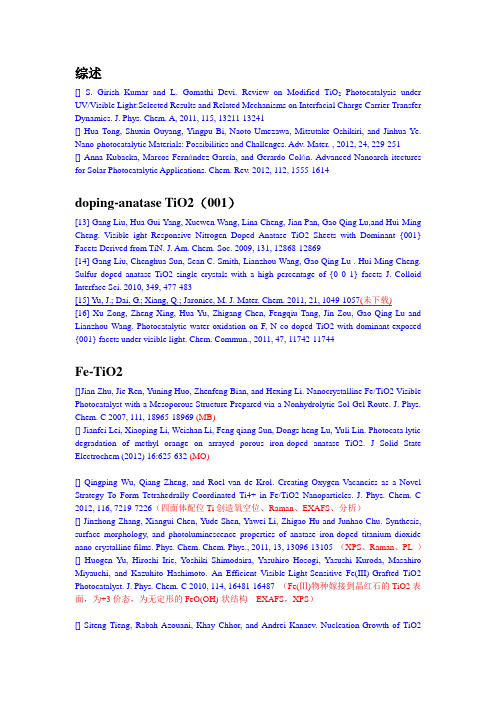
综述[] S. Girish Kumar and L. Gomathi Devi. Review on Modified TiO2Photocatalysis under UV/Visible Light:Selected Results and Related Mechanisms on Interfacial Charge Carrier Transfer Dynamics. J. Phys. Chem. A, 2011, 115, 13211-13241[] Hua Tong, Shuxin Ouyang, Yingpu Bi, Naoto Umezawa, Mitsutake Oshikiri, and Jinhua Ye. Nano-photocatalytic Materials: Possibilities and Challenges. Adv. Mater. , 2012, 24, 229-251[] Anna Kubacka, Marcos Fernández-García, and Gerardo Colón. Advanced Nanoarch itectures for Solar Photocatalytic Applications. Chem. Rev. 2012, 112, 1555-1614doping-anatase TiO2(001)[13] Gang Liu, Hua Gui Yang, Xuewen Wang, Lina Cheng, Jian Pan, Gao Qing Lu,and Hui-Ming Cheng. Visible ight Responsive Nitrogen Doped Anatase TiO2 Sheets with Dominant {001} Facets Derived from TiN. J. Am. Chem. Soc. 2009, 131, 12868-12869[14] Gang Liu, Chenghua Sun, Sean C. Smith, Lianzhou Wang, Gao Qing Lu . Hui-Ming Cheng. Sulfur doped anatase TiO2 single crystals with a high percentage of {0 0 1} facets J. Colloid Interface Sci. 2010, 349, 477-483[15] Yu, J.; Dai, G.; Xiang, Q.; Jaroniec, M. J. Mater. Chem. 2011, 21, 1049-1057(未下载)[16] Xu Zong, Zheng Xing, Hua Yu, Zhigang Chen, Fengqiu Tang, Jin Zou, Gao Qing Lu and Lianzhou Wang. Photocatalytic water oxidation on F, N co-doped TiO2 with dominant exposed {001} facets under visible light. Chem. Commun., 2011, 47, 11742-11744Fe-TiO2[]Jian Zhu, Jie Ren, Yuning Huo, Zhenfeng Bian, and Hexing Li. Nanocrystalline Fe/TiO2 Visible Photocatalyst with a Mesoporous Structure Prepared via a Nonhydrolytic Sol-Gel Route. J. Phys. Chem. C 2007, 111, 18965-18969 (MB)[] Jianfei Lei, Xiaoping Li, Weishan Li, Feng qiang Sun, Dongs heng Lu, Yuli Lin. Photocata lytic degradation of methyl orange on arrayed porous iron-doped anatase TiO2. J Solid State Electrochem (2012) 16:625-632 (MO)[] Qingping Wu, Qiang Zheng, and Roel van de Krol. Creating Oxygen Vacancies as a Novel Strategy To Form Tetrahedrally Coordinated Ti4+ in Fe/TiO2 Nanoparticles. J. Phys. Chem. C 2012, 116, 7219-7226(四面体配位Ti创造氧空位、Raman、EXAFS、分析)[] Jinzhong Zhang, Xiangui Chen, Yude Shen, Yawei Li, Zhigao Hu and Junhao Chu. Synthesis, surface morphology, and photoluminescence properties of anatase iron-doped titanium dioxide nano-crystalline films. Phys. Chem. Chem. Phys., 2011, 13, 13096-13105 (XPS、Raman、PL )[] Huogen Yu, Hiroshi Irie, Yoshiki Shimodaira, Yasuhiro Hosogi, Yasushi Kuroda, Masahiro Miyauchi, and Kazuhito Hashimoto. An Efficient Visible-Light-Sensitive Fe(III)-Grafted TiO2 Photocatalyst. J. Phys. Chem. C 2010, 114, 16481-16487 (Fe(Ⅲ)物种嫁接到晶红石的TiO2表面,为+3价态,为无定形的FeO(OH)-状结构---EXAFS,XPS)[] Siteng Tieng, Rabah Azouani, Khay Chhor, and Andrei Kanaev. Nucleation-Growth of TiO2Nanoparticles Doped with Iron Acetylacetonate. J. Phys. Chem. C 2011, 115, 5244-5250(前言不错)[] Wen-Churng Lin, Rui Liu, Wein-Duo Yang Effect of Iron (III)-Doping on the Photocatalytic Activity of Titanium Dioxide Catalysts for Methylene Blue Degradation. Applied Mechanics and Materials Vols. 117-119 (2012) pp 1088-1091(MB)[] Xiaodong Hu, Hua Deng and Lin Du. Preparation and Characterization of Fe3+/ TiO2 thin films loaded Activated carbon and and Degradation of Methyl Orange. Advanced Materials Research V ols. 332-334 (2011) pp 134-137(MO)[] Beata Tryba, Antoni W. Morawski, Michio Inagaki, Masahiro Toyoda. Mechanism of phenol decomposition on Fe-C-TiO2 and Fe-TiO2 photocatalysts via photo-Fenton process. Journal of Photochemistry and Photobiology A: Chemistry 179 (2006) 224-228[][][]水热法[7] M. Alam Khana, Seong Ihl Woob, O.-Bong Yanga. Hydrothermally stabilized Fe(III) doped titania active under visible light for water splitting reaction. International journal of hydrogen energy. 2008, 33, 5345-5351[8] Jinlong Zhang, Ling Xiao, Ye Cong Masakazu Anpo. Preparation and Characterization of Multi-functional Titanium Dioxide Photocatalysts. Top Catal, 2008, 47, 122-130[9] Zhibo Zhang, Chen-Chi Wang, Rama Zakaria, and Jackie Y. Ying. Role of Particle Size in Nanocrystalline TiO2-Based Photocatalysts. J. Phys. Chem. B, 1998, 102, 10871-10878[] MINGMING CHENG, WANHONG MA, JING LI, YINGPING HUANG, AND JINCAI ZHAO. Visible-Light-Assisted Degradation of Dye Pollutants over Fe(III)-Loaded Resin in the Presence of H2O2 at Neutral pH Values. Environ. Sci. Technol. 2004, 38, 1569-1575 (H2O2存在下,几种染料在不同pH下的降解情况,降解产物进行GC分析)[] Saji George, Suman Pokhrel, Zhaoxia Ji, Bryana L. Henderson, Tian Xia, LinJiang Li, Jeffrey I. Zink, AndréE. Nel, and Lutz Mädler. Role of Fe Doping in Tuning the Band Gap of TiO2 for the Photo-Oxidation-Induced Cytotoxicity Paradigm. J. Am. Chem. Soc. 2011, 133, 11270–11278(生物毒性)[] David L. Reid, Kevin R. Kreitz, Matthew A. Stephens, Jessica E. S. King, Ponnusamy Nachimuthu, Eric L. Petersen, and Sudipta Seal. Development of Highly Active Titania-Based Nanoparticles for Energetic Materials. J. Phys. Chem. C 2011, 115, 10412–10418 (形成机理、能源材料、XPS)[] Jiaguo Yu, Quanjun Xiang, Minghua Zhou. Preparation, characterization and visible-light-driven photocatalytic activity of Fe-doped titania nanorods and first-principles study for electronic structures. Applied Catalysis B: Environmental 90 (2009) 595-602[] Nasrin Farhangi, Rajib Roy Chowdhury, Yaocihuatl Medina-Gonzalez, Madhumita B. Ray, Paul A. Charpentier. Visible light active Fe doped TiO2 nanowires grown on graphene using supercritical CO2. Applied Catalysis B: Environmental 110 (2011) 25-32[] Zohreh Mesgari, Mehrnaz Gharagozlou, Alireza Khosravi, Kamaladin Gharanjig. Spectrophotometric studies of visible light induced photocatalytic degradation of methyl orange using phthalocyanine-modified Fe-doped TiO2 nanocrystals. Spectrochimica Acta Part A, 92 (2012) 148-153[]doping TiO2[] Effects of Single Metal-Ion Doping on the Visible-Light Photoreactivity of TiO2. Jina Choi, Hyunwoong Park, and Michael R. Hoffmann. J. Phys. Chem. C 2010, 114, 783-792[] Kitirote Wantala, Laksana Laokiat, Pongtanawat Khemthong, Nurak Grisdanurak, Keisuke Fukaya. Calcination temperature effect on solvothermal Fe-TiO2 and its performance under visible light irradiation. Journal of the Taiwan Institute of Chemical Engineers 41 (2010) 612-616 [] Zengcai Guo, Bin Chen, Jingbo Mu, Mingyi Zhang, Peng Zhang, Zhenyi Zhang, Jingfeng Wang, Xin Zhang, Yangyang Sun, Changlu Shao, Yichun Liu. Iron phthalocyanine/TiO2 nanofiber heterostructures with enhanced visible photocatalytic activity assisted with H2O2. Journal of Hazardous Materials, xxx (2012) xxx-xxxco-doping TiO2[] Dambar B. Hamal and Kenneth J. Klabunde. Valence State and Catalytic Role of Cobalt Ions in Cobalt TiO2 Nanoparticle Photocatalysts for Acetaldehy de Degradation under Visible Light. J. Phys. Chem. C 2011, 115, 17359-17367[] Mingyang Xing, Yongmei Wu, Jinlong Zhang and Feng Chen. Effect of synergy on the visible light activity of B, N and Fe co-doped TiO2 for the degradation of MO. Nanoscale, 2010, 2 , 1233-1239半导体复合TiO2[] Enhancement of the Visible-Light Photocatalytic Activity of In2O3-TiO2 Nanofiber Heteroarchitectures. Jingbo Mu, Bin Chen, Mingyi Zhang, Zengcai Guo, Peng Zhang, Zhenyi Zhang, Yangyang Sun, Changlu Shao, and Yichun Liu. ACS Appl. Mater. Interfaces2012, 4, 424-430[] Jingqun Gao, Xiaoyu Luan, Jun Wang, Baoxin Wang, Kai Li, Ying Li, Pingli Kang, Guangxi Han. Preparation of Er3+:YAlO3/Fe-doped TiO2-ZnO and its application in photocatalyticdegradation of dyes under solar light irradiation. Desalination 268 (2011) 68-75[] Qiuye Li, Tetsuya Kako and Jinhua Ye. WO3 modified titanate network film: highly efficient photo-mineralization of 2-propanol under visible light irradiation. Chem. Commun., 2010, 46, 5352-5354形成机理[] Zhenfeng Bian, Jian Zhu, Jinguo Wang, Shengxiong Xiao, Colin Nuckolls, and Hexing Li. Multitemplates for the Hierarchical Synthesis of Diverse Inorganic Materials. J. Am. Chem.Soc. 2012, 134, 2325- 2331[] Puhong Wen, Hiroshi Itoh, Weiping Tang, and Qi Feng. Single Nanocrystals of Anatase-Type TiO2 Prepared from Layered Titanate Nanosheets: Formation Mechanism and Characterization of Surface Properties. Langmuir 2007, 23, 11782-11790[] Raffaella Buonsanti, Elvio Carlino, Cinzia Giannini, Davide Altamura, Luisa De Marco, Roberto Giannuzzi, Michele Manca, Giuseppe Gigli, and P. Davide Cozzoli. Hyperbranched Anatase TiO2Nanocrystals: Nonaqueous Synthesis, Growth Mechanism, and Exploitation in Dye-Sensitized Solar Cells. J. Am. Chem. Soc. 2011, 133, 19216-19239[] Guohui Tian, Yajie Chen, Wei Zhou, Kai Pan, Chungui Tian, Xu-ri Huang and Honggang Fu. 3D hierarchical flower-like TiO2 nanostructure: morphology control and its photocatalytic property. CrystEngComm , 2011, 13, 2994Au/TiO2 catalysts[] Xingdong Wang, David R. G. Mitchell, Kathryn Prince, Armand J. Atanacio, and Rachel A. Caruso. Gold Nanoparticle Incorporation into Porous Titania Networks Using an Agarose Gel Templating Technique for Photocatalytic Applications. Chem. Mater. 2008, 20, 3917-3926 (MB降解,英文相关表达可用,表征分析不好)[] Parvaneh Sangpour, Fatemeh Hashemi, and Alireza Z. Moshfegh. Photoenhanced Degradation of Methylene Blue on Cosputtered M:TiO2 (M=Au, Ag, Cu) Nanocomposite Systems: A Comparative Study. J. Phys. Chem. C 2010, 114, 13955-13961 (Cu:TiO2 > Au:TiO2 >Ag:TiO2 > TiO2、反应动力学和降解原理分析、AFM原子力显微镜测表面粗糙度、XPS分析、)3] Junya Ohyama, Akira Yamamoto, Kentaro Teramura, Tetsuya Shishido, and Tsunehiro Tanaka. Modification of Metal Nanoparticles with TiO2 and Metal- Support interaction in Photodeposition. ACS Catal.2011, 1, 187-192 (XAFS、XPS分析,)[] Xingdong Wang, Mark Blackford, Kathryn Prince, and Rachel A. Caruso. Preparation ofBoron-Doped Porous Titania Networks Containing Gold Nanoparticles with EnhancedVisible-Light Photocatalytic Activity. ACS Appl. Mater. Interfaces2012, 4, 476-482 ()[] Hexing Li, Zhenfeng Bian, Jian Zhu, Y uning Huo, Hui Li, and Yunfeng Lu. MesoporousAu/TiO2 Nanocomposites with Enhanced Photocatalytic Activity. J. AM. CHEM. SOC. 2007 , 129 , 4538-4539[] I.M. Arabatzis, T. Stergiopoulos, D. Andreeva, S. Kitova, S.G. Neophytides, and P. Falaras. Characterization and photocatalytic activity of Au /TiO2 thin films for azo-dye degradation.Journal of Catalysis 220 (2003) 127-135[] Panneer Selvam Sathish Kumar, Radhakrishnan Sivakumar, Sambandam Anandan, Jagannathan Madhavan, Pichai Maruthamuthu, Muthupandian Ashokkumar.Photocatalytic degradation of Acid Red 88 using Au-TiO2 nanoparticles in aqueous solutions. water research 42 (2008) 4878-4884 [] Ewa Kowalska, Orlando Omar Prieto Mahaney, Ryu Abe and Bunsho Ohtani.Visible-light-induced photocatalysis through surface plasmon excitation of gold on titania surfaces. Phys. Chem. Chem. Phys., 2010, 12, 2344-2355[] The effect of gold loading and particle size on photocatalytic hydrogen production from ethanol over Au/TiO2 nanoparticles. M. Murdoch, G.I.N.Waterhouse, M.A.Nadeem, J.B.Metson,M.A.Keane, R.F.Howe, J. Llorca and H. Idriss.[] Yongmei Wu, Haibei Liu, Jinlong Zhang, and Feng Chen. Enhanced Photocatalytic Activity of Nitrogen-Doped Titania by Deposited with Gold. J. Phys. Chem. C 2009, 113, 14689-14695[] Girish Ramakrishnan, Shen Zhao, Weiqiang Han, Alexander Orlov. Simultaneous observation of gas phase and surface species in photocatalytic reactions on nanosize Au modified TiO2: The next generation of DRIFTS systems. Chemical Engineering Journal170 (2011) 445-450 (原位气相光催化NO2)Au/ZnO catalysts[1]。
细胞生物学(第4版)翟中和 名词解释
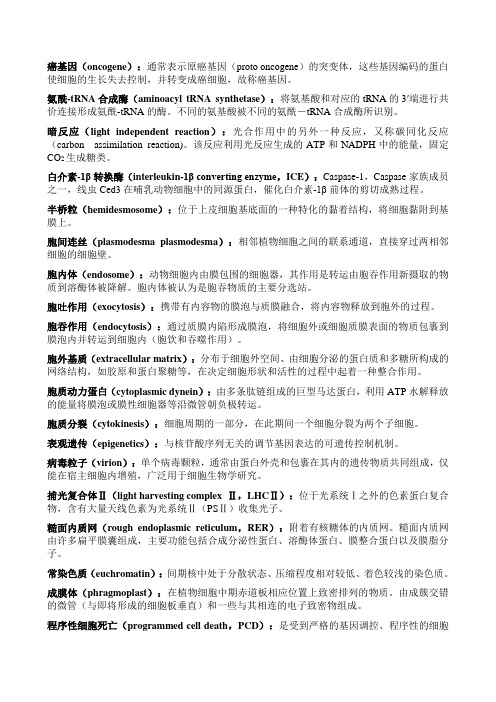
癌基因(oncogene):通常表示原癌基因(proto oncogene)的突变体,这些基因编码的蛋白使细胞的生长失去控制,并转变成癌细胞,故称癌基因。
氨酰-tRNA合成酶(aminoacyl tRNA synthetase):将氨基酸和对应的tRNA的3′端进行共价连接形成氨酰-tRNA的酶。
不同的氨基酸被不同的氨酰-tRNA合成酶所识别。
暗反应(light independent reaction):光合作用中的另外一种反应,又称碳同化反应(carbon assimilation reaction)。
该反应利用光反应生成的ATP和NADPH中的能量,固定CO2生成糖类。
白介素-1β转换酶(interleukin-1β converting enzyme,ICE):Caspase-1,Caspase家族成员之一,线虫Ced3在哺乳动物细胞中的同源蛋白,催化白介素-1β前体的剪切成熟过程。
半桥粒(hemidesmosome):位于上皮细胞基底面的一种特化的黏着结构,将细胞黏附到基膜上。
胞间连丝(plasmodesma plasmodesma):相邻植物细胞之间的联系通道,直接穿过两相邻细胞的细胞壁。
胞内体(endosome):动物细胞内由膜包围的细胞器,其作用是转运由胞吞作用新摄取的物质到溶酶体被降解。
胞内体被认为是胞吞物质的主要分选站。
胞吐作用(exocytosis):携带有内容物的膜泡与质膜融合,将内容物释放到胞外的过程。
胞吞作用(endocytosis):通过质膜内陷形成膜泡,将细胞外或细胞质膜表面的物质包裹到膜泡内并转运到细胞内(胞饮和吞噬作用)。
胞外基质(extracellular matrix):分布于细胞外空间、由细胞分泌的蛋白质和多糖所构成的网络结构,如胶原和蛋白聚糖等,在决定细胞形状和活性的过程中起着一种整合作用。
胞质动力蛋白(cytoplasmic dynein):由多条肽链组成的巨型马达蛋白,利用ATP水解释放的能量将膜泡或膜性细胞器等沿微管朝负极转运。
炎症小体的活化及调控机制研究进展_赵西宝
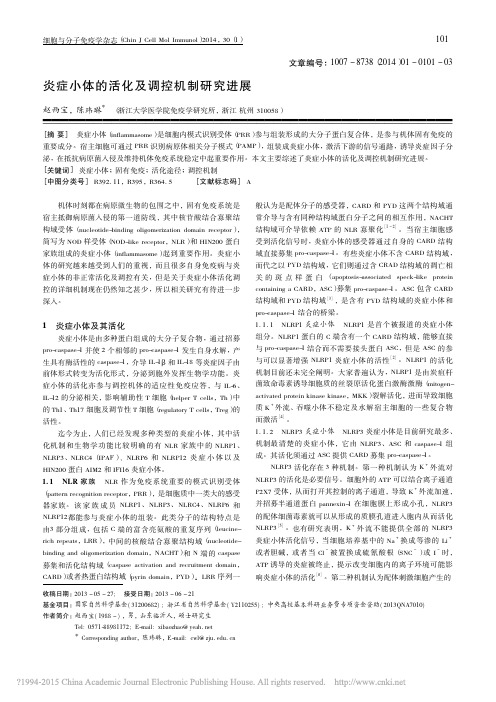
文章编号:1007-8738(2014)01-0101-03炎症小体的活化及调控机制研究进展赵西宝,陈玮琳*(浙江大学医学院免疫学研究所,浙江杭州310058)收稿日期:2013-05-27;接受日期:2013-06-21基金项目:国家自然科学基金(31200682);浙江省自然科学基金(Y2110255);中央高校基本科研业务费专项资金资助(2013QNA7010)作者简介:赵西宝(1988-),男,山东临沂人,硕士研究生Tel :0571-********;E-mail :xibaozhao@yeah.net*Corresponding author ,陈玮琳,E-mail :cwl@zju.edu.cn[摘要]炎症小体(inflammasome )是细胞内模式识别受体(PRR)参与组装形成的大分子蛋白复合体,是参与机体固有免疫的重要成分。
宿主细胞可通过PRR识别病原体相关分子模式(PAMP ),组装成炎症小体,激活下游的信号通路,诱导炎症因子分泌,在抵抗病原菌入侵及维持机体免疫系统稳定中起重要作用。
本文主要综述了炎症小体的活化及调控机制研究进展。
[关键词]炎症小体;固有免疫;活化途径;调控机制[中图分类号]R392.11,R395,R364.5[文献标志码]A机体时刻都在病原微生物的包围之中,固有免疫系统是宿主抵御病原菌入侵的第一道防线,其中核苷酸结合寡聚结构域受体(nucleotide-binding oligomerization domain receptor ),简写为NOD 样受体(NOD-like receptor ,NLR)和HIN200蛋白家族组成的炎症小体(inflammasome )起到重要作用。
炎症小体的研究越来越受到人们的重视,而且很多自身免疫病与炎症小体的非正常活化及调控有关,但是关于炎症小体活化调控的详细机制现在仍然知之甚少,所以相关研究有待进一步深入。
1炎症小体及其活化炎症小体是由多种蛋白组成的大分子复合物,通过招募pro-caspase-1并使2个相邻的pro-caspase-1发生自身水解,产生具有酶活性的caspase-1,介导IL-1β和IL-18等炎症因子由前体形式转变为活化形式,分泌到胞外发挥生物学功能。
翻译沃森和克里克于1953年发表在《科学杂志》关于DNA双螺旋模型的论文

分子生物学作业:翻译沃森和克里克于1953年发表在《科学杂志》上的关于DNA双螺旋模型的论文Nature科学杂志Equipment,and to Dr. G. E. R. Deacon and the captain and officers of R.R.S.Discovery II for their part,in making the observations.Molecular structure of nucleic acids核酸分子结构A structure for Deoxyribose nucleic acid脱氧核糖核酸的结构We wish to suggest a structure for the salt of deoxyribose nucleic acid (D.N.A). This structure has novel features which are of considerable biological interest.我们希望去提出一种结构是刺激性的脱氧核糖核酸即DNA。
这个结构有一些新的特征对于生物学有很多重要的意义。
A structure for nucleic acid has already been proposed by Pauling and Corey2.鲍林和科瑞提出了核酸的结构。
they kindly made their manuscript available to us in advance of publication.在他们出版前,他们爽快的将对他们有用的手稿给我们。
Their model consists of three intertwined chains,with the phosphates near the fibre axis,and the bases on the outside.他们提出的模型由三个缠绕的链组成,以磷酸盐靠近纤维轴线并且盘绕在外部。
Does Asian dust play a role of CCN - Test Page for the
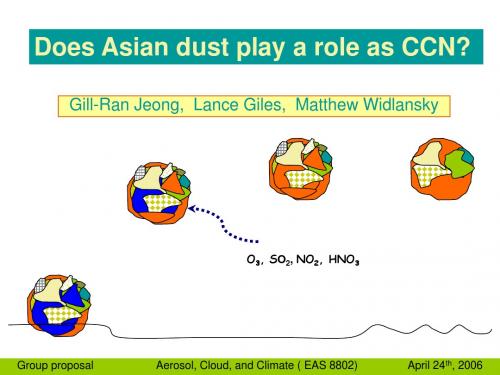
4. Experimental instruments
Measured Quantity
Past long-term dust concentration monthly mean precipitation 3-hour average cloud Cloud profile Liquid and ice contents Rain drop and precipitation Aerosol profile Cloud profile Optical depth of thin cirrus cloud Aerosol optical depth Particle size TOA radiation budget Dust size distribution
2. Investigate satellite observations pertaining to dust, clouds and precipitation with the same temporal and spatial resolution. (Cloudsat, MODIS and CALIPSO) 3. Investigate data from airborne and ground-base measurements of dust size distribution, chemical composition, and pH of precipitation.
2. What do we want to see? During dust and non-dust period: i) Vertical profiles of the CCN, clouds, water vapor ii) Time required for a dust CCN to grow into cloud droplets. iii) Size resolved chemical composition
钙钛矿结构及相关功能材料

钙钛矿结构中基本的 (AO3)4- (111) 面的密堆层
2)结构特点:
氧八面体共顶点连接,组成三维网络,根据Pauling的配位多面体连接规则,此种结构比共棱、共面连接稳定。 共顶连接使氧八面体网络之间的空隙比共棱、共面连接时要大,允许较大尺寸离子填入,即使产生大量晶体缺陷,或者各组成离子的尺寸与几何学要求有较大出入时,仍然能够保持结构稳定;并有利于氧及缺陷的扩散迁移。
磁性金属多层膜GMR效应
图 Co/Cu多层膜的磁电阻与Cu层厚度tCu的关系曲线
Co/Cu多层膜的磁电阻与Cu层厚度tCu为0.9、1.9、3.0nm处,分别有一明显的峰值,对应反铁磁耦合,谷对应铁磁耦合。随着非磁层厚度的变化,多层膜中磁层的层间耦合在反铁磁与铁磁间振荡,磁电阻值也在极大与极小间振荡。
对于自发极化而言,从宏观统计来看,晶体中存在着各个方向的自发极化和电畴,它们相互抵消,宏观上对外不呈现极性。
外电场作用时,沿电场方向极化畴长大,逆电场方向的畴消失,其它方向分布的电畴转到电场方向,极化强度随外加电场的增加而增加,一直到整个结晶体成为一个单一的极化畴为止。如再继续增加电场只有电子与离子的极化效应,和一般电介质一样。
在机械应力的作用下介质发生极化,形成晶体表面电荷的效应称为压电效应。
01
反之,当外加电场于晶体,晶体发生形变的效应称为逆压电效应。逆压电效应也称电致伸缩效应。这样的性质称为晶体的压电性。具有压电效应的晶体称为压电体。
02
热释电效应:具有自发极化的晶体在温度发生变化,其极化状态的发生改变,使电介质对外显电性。
在La2/3Ca1/3MnO3中,低价态Ca的掺入,使得Mn采取+3和+4的混合价态,从而满足钙钛矿结构的电价要求。在Ca2CaUO6中,有1/3的Ca与U交替占据钙钛矿型晶格的B位。在Ba2Bi2O6中,有一半Bi原子为+3价,另一半为+5价。
群落构建的中性理论和生态位理论
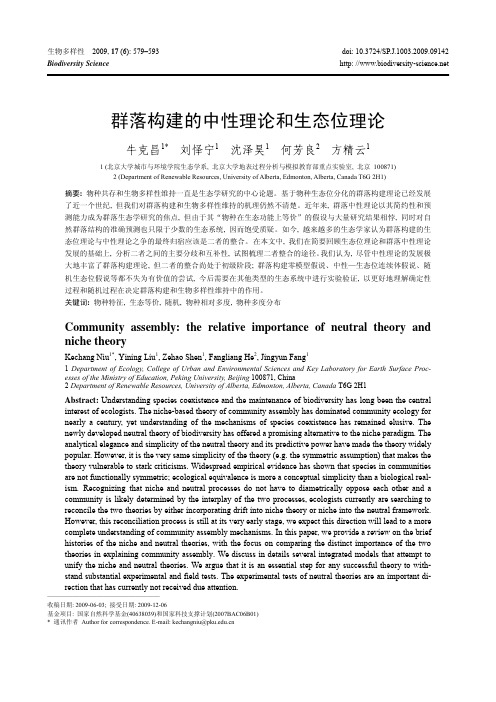
向于认为, 在群落构建中生态位理论和中性理论并 非对立, 将生态位理论和中性理论整合可以更好地 理解群落构建的机理 (Tilman, 2004; Chase, 2005; Gravel et al., 2006; Leibold & McPeek, 2006)。 本文试图在简要回顾群落中性理论和生态位 理论发展的基础上, 梳理其最新研究进展, 并探讨 整合生态位理论和中性理论, 解释群落构建和多样 性维持的可能途径。
Biodiversity Science
群落构建的中性理论和生态位理论
牛克昌1* 刘怿宁1 沈泽昊1 何芳良2 方精云1
1 (北京大学城市与环境学院生态学系, 北京大学地表过程分析与模拟教育部重点实验室, 北京 100871) 2 (Department of Renewable Resources, University of Alberta, Edmonton, Alberta, Canada T6G 2H1)
1
群落构建的生态位理论
关于群落多样性的形成和维持机理, 主要存在
两类不同的观点。一种观点认为, 在群落构建和多 样性维持中, 共存物种间的生态位分化等确定性因 素占主导地位; 而另一种观点则认为扩散和随机作 用是主要决定因子。关于群落构建的确定性和非确 定性因素, 达尔文在其巨著《物种起源》中早有所 提及。他认为看似偶然生长在一起的群落物种, 其 背后有着深刻的必然性。而对确定性因素和随机作 用在群落构建中的地位较为系统的讨论, 可以追溯 到20世纪初的群落超有机体论(super-organism concept) (Clements, 1916; Tansley, 1935) 和 个 体 论 (individualistic concept)(Gleason, 1926) 的争论。以 Clements为代表的群落有机体学派认为, 群落构建 是确定性过程, 群落之间有着可分辨的边界, 群落 在受干扰后能够逐渐演变到原来的状态, 即群落演 替; 在群落组分种的相互作用下, 演替是从一个方 向有规律地向另一个方向变化, 演替的最后阶段是 稳定的单元顶极(monoclimax)(Clements, 1916)或多 元顶极(polyclimax)(Tansley, 1935)。 对此, 以Gleason 为代表的群落个体学派提出了猛烈的批评, 他们认 为群落只是一些物种的随机组合, 群落之间并没有 明显的界限 , 群落结构变化也没有明确的方向性 , 各物种以其独特的方式响应着环境的时空变化。其 后, 岛屿生物地理学的出现、 群落构建规则的提出以 及群落中性理论的蓬勃发展, 将群落构建中确定性 作用和随机过程的相对重要性的讨论推向了高潮。 1.1 生态位和物种共存机制 早在1910年Johnson就率先提出了生态位概念。
《向日葵四跨膜蛋白(Tetraspanin,TET)家族基因在向日葵—列当寄生体系中的作用研究》范文
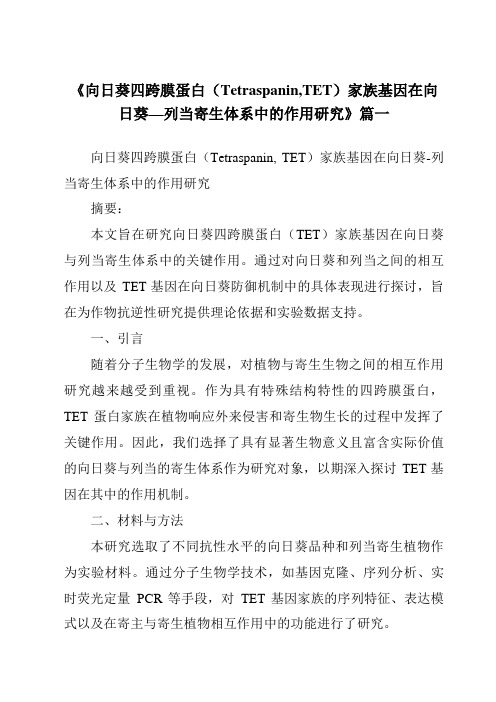
《向日葵四跨膜蛋白(Tetraspanin,TET)家族基因在向日葵—列当寄生体系中的作用研究》篇一向日葵四跨膜蛋白(Tetraspanin, TET)家族基因在向日葵-列当寄生体系中的作用研究摘要:本文旨在研究向日葵四跨膜蛋白(TET)家族基因在向日葵与列当寄生体系中的关键作用。
通过对向日葵和列当之间的相互作用以及TET基因在向日葵防御机制中的具体表现进行探讨,旨在为作物抗逆性研究提供理论依据和实验数据支持。
一、引言随着分子生物学的发展,对植物与寄生生物之间的相互作用研究越来越受到重视。
作为具有特殊结构特性的四跨膜蛋白,TET蛋白家族在植物响应外来侵害和寄生物生长的过程中发挥了关键作用。
因此,我们选择了具有显著生物意义且富含实际价值的向日葵与列当的寄生体系作为研究对象,以期深入探讨TET基因在其中的作用机制。
二、材料与方法本研究选取了不同抗性水平的向日葵品种和列当寄生植物作为实验材料。
通过分子生物学技术,如基因克隆、序列分析、实时荧光定量PCR等手段,对TET基因家族的序列特征、表达模式以及在寄主与寄生植物相互作用中的功能进行了研究。
三、TET基因家族的序列特征通过基因克隆和序列分析,我们发现向日葵中存在多个TET 基因家族成员。
这些基因在编码区具有相似的四跨膜结构特征,但其在启动子区域和调控序列上存在差异,这可能与其在不同生物学过程中的功能差异有关。
四、TET基因在向日葵防御机制中的作用1. 表达模式分析:通过实时荧光定量PCR技术,我们发现在列当寄生过程中,TET基因的表达水平会发生显著变化。
特别是在受到寄生攻击的早期阶段,某些TET基因的表达量显著增加,这表明它们可能参与了向日葵的早期防御反应。
2. 抗性分析:我们对不同抗性水平的向日葵品种进行了比较研究。
结果显示,高抗性品种在列当寄生过程中TET基因的表达水平更高,这表明TET基因可能参与了向日葵的抗性反应。
3. 遗传转化研究:通过遗传转化技术,我们成功地将某些TET基因转入易感品种中,得到了对列当抗性增强的转基因品种。
免疫学基本概念

Ig的两种形式: 分泌型(Secreted /Soluble antibody )
膜型(membrane Ig, mIg):BCR
二、Ig分子的结构(structure)
“Y”字型的四肽链,两 条完全相同的重链(H) 和两条完全相同的轻 链(L)通过二硫键连接而 成。 H链:约450~550氨基酸 L链:约210氨基酸
化学屏障:溶菌酶、抗菌肽、补体、细胞因子、APR等 细胞屏障:粒细胞、M 、DC、NK等
适应性免疫(Adaptive Immunity)
概念: 个体发育过程中接触特定抗原后产生, 仅针对该 特定抗原而发生反应.
特点: 特异性; 耐受性; 记忆性 效应细胞: T细胞(介导细胞免疫应答)
B细胞(介导体液免疫应答) 分为三阶段:识别阶段、
CH3(IgG)/ CH4(IgE, IgM)结合细胞功能:
Secreted Ig: Binding to cells by Fc receptors.
Membrane Ig: An extracellular hydrophilic “spacer” sequence composed of 26 amino acid residues. A hydrophobic transmembrane sequence A short cytoplasmic tail
Overall configuration of a hapten plays a major role in determining whether it can react with a given antibody.
抗原的特异性
克隆选择学说
抗原表位决定抗原的特异性
原位表征 综述
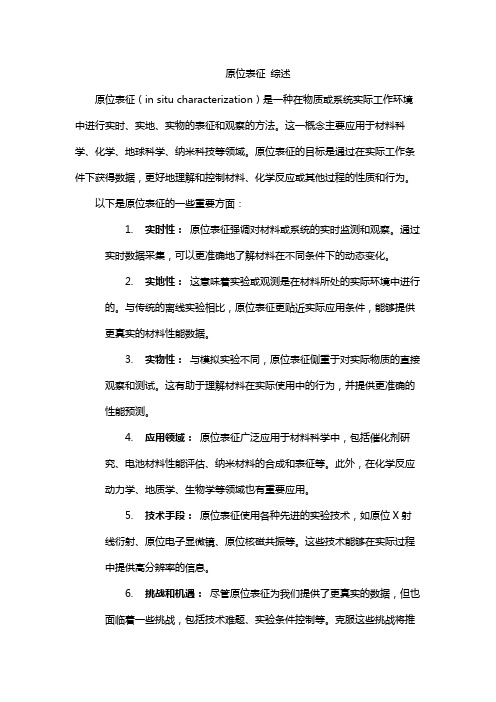
原位表征综述原位表征(in situ characterization)是一种在物质或系统实际工作环境中进行实时、实地、实物的表征和观察的方法。
这一概念主要应用于材料科学、化学、地球科学、纳米科技等领域。
原位表征的目标是通过在实际工作条件下获得数据,更好地理解和控制材料、化学反应或其他过程的性质和行为。
以下是原位表征的一些重要方面:1.实时性:原位表征强调对材料或系统的实时监测和观察。
通过实时数据采集,可以更准确地了解材料在不同条件下的动态变化。
2.实地性:这意味着实验或观测是在材料所处的实际环境中进行的。
与传统的离线实验相比,原位表征更贴近实际应用条件,能够提供更真实的材料性能数据。
3.实物性:与模拟实验不同,原位表征侧重于对实际物质的直接观察和测试。
这有助于理解材料在实际使用中的行为,并提供更准确的性能预测。
4.应用领域:原位表征广泛应用于材料科学中,包括催化剂研究、电池材料性能评估、纳米材料的合成和表征等。
此外,在化学反应动力学、地质学、生物学等领域也有重要应用。
5.技术手段:原位表征使用各种先进的实验技术,如原位X射线衍射、原位电子显微镜、原位核磁共振等。
这些技术能够在实际过程中提供高分辨率的信息。
6.挑战和机遇:尽管原位表征为我们提供了更真实的数据,但也面临着一些挑战,包括技术难题、实验条件控制等。
克服这些挑战将推动原位表征方法的发展,并为更深入的科学研究提供可能性。
总体而言,原位表征是一种强大的工具,有助于科学家们更全面地理解材料和过程的性质,从而推动材料科学和相关领域的研究取得更多突破。
蛋白的高尔基体定位_王玲霞
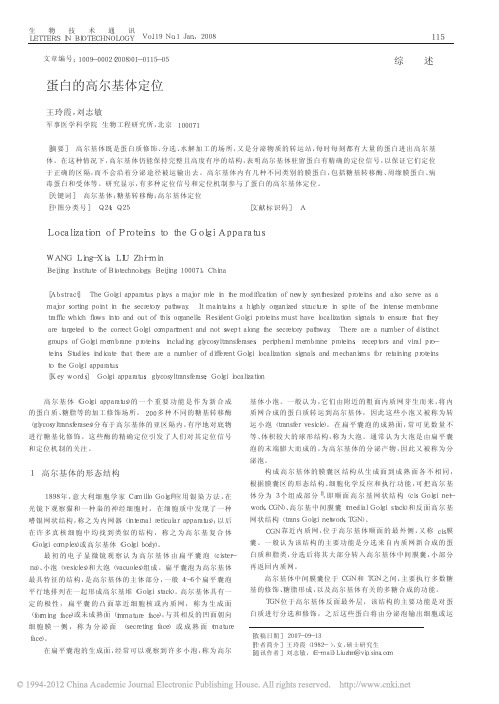
文章编号:1009-0002(2008)01-0115-05综述蛋白的高尔基体定位王玲霞,刘志敏军事医学科学院生物工程研究所,北京100071[摘要]高尔基体既是蛋白质修饰、分选、水解加工的场所,又是分泌物质的转运站,每时每刻都有大量的蛋白进出高尔基体。
在这种情况下,高尔基体仍能保持完整且高度有序的结构,表明高尔基体驻留蛋白有精确的定位信号,以保证它们定位于正确的区隔,而不会沿着分泌途径被运输出去。
高尔基体内有几种不同类别的膜蛋白,包括糖基转移酶、周缘膜蛋白、病毒蛋白和受体等。
研究显示,有多种定位信号和定位机制参与了蛋白的高尔基体定位。
[关键词]高尔基体;糖基转移酶;高尔基体定位[中图分类号]Q24-Q25[文献标识码]ALocalizationofProteinstotheGolgiApparatusWANGLing-Xia,LIUZhi-minBeijingInstituteofBiotechnology,Beijing100071,China[Abstract]TheGolgiapparatusplaysamajorroleinthemodificationofnewlysynthesizedproteinsandalsoserveasamajorsortingpointinthesecretorypathway.Itmaintainsahighlyorganizedstructureinspiteoftheintensemembranetrafficwhichflowsintoandoutofthisorganelle.ResidentGolgiproteinsmusthavelocalizationsignalstoensurethattheyaretargetedtothecorrectGolgicompartmentandnotsweptalongthesecretorypathway.ThereareanumberofdistinctgroupsofGolgimembraneproteins,includingglycosyltransferases,peripheralmembraneproteins,receptorsandviralpro-teins.StudiesindicatethatthereareanumberofdifferentGolgilocalizationsignalsandmechanismsforretainingproteinstotheGolgiapparatus.[Keywords]Golgiapparatus-glycosyltransferase-Golgilocalization高尔基体(Golgiapparatus)的一个重要功能是作为新合成的蛋白质、糖脂等的加工修饰场所。
- 1、下载文档前请自行甄别文档内容的完整性,平台不提供额外的编辑、内容补充、找答案等附加服务。
- 2、"仅部分预览"的文档,不可在线预览部分如存在完整性等问题,可反馈申请退款(可完整预览的文档不适用该条件!)。
- 3、如文档侵犯您的权益,请联系客服反馈,我们会尽快为您处理(人工客服工作时间:9:00-18:30)。
Role of surface structure in heterogeneous nucleationYusen Qi,James F.Klausner *,Renwei MeiDepartment of Mechanical and Aerospace Engineering,University of Florida,P.O.Box 116300,Gainesville,FL 32611-6300,USAReceived 23July 2003;received in revised form 23February 2004Available online 17April 2004AbstractNucleation site density measurements have been made for water on brass and stainless steel surfaces using a gas nucleation technique.It has been observed that nucleation sites are substantially more populated on the brass surface compared with the stainless steel surface.The difference is attributed to variations in the detailed surface structure.A vertical scanning interferometer has been used to gather statistical data on cavity mouth diameters and cavity half cone angles for the brass and stainless steel surfaces.The statistical data have been used to predict the nucleation site density,and satisfactory agreement is fortuitously obtained for the brass surface,while poor agreement is obtained for the stainless steel surface.Due to the large uncertainty in the probability of finding cavities that satisfy the gas trapping criteria,the statistical method does not appear to be useful for predicting nucleation site density on surfaces with randomly distributed cavities.It has been observed that only deep cavities are suitable for trapping vapor.Ó2004Elsevier Ltd.All rights reserved.Keywords:Nucleation site density;Surface structure;Gas nucleation1.IntroductionIt is well known that the development of reliable mechanistic boiling models requires information on the nucleation site density.Therefore it has been the goal of researchers for the past 50years to understand hetero-geneous nucleation in boiling systems and develop cor-relations and models to predict its dependence on wall superheat,wettability,and surface structure.Corty and Foust [1]recognized that boiling takes place on surfaces with irregularities.They suggested that vapor trapped in these surface irregularities served as nucleation sites.This hypothesis was confirmed by Clark et al.[2]using micrographs of the heating surface.Gaertner and Westwater [3]measured the nucleation site density for a water and nickel-salt solution boiling on a copper sur-face.It was found that n =A is proportional to q 2w ,where n =A is the nucleation site density and q w is the wall heat flux.Kurihara and Meyers [4]demonstrated that n =A ishighly dependent on the roughness of the boiling sur-face.An important breakthrough in quantitatively relating the heating surface microstructure to nucleation phe-nomena was made by Griffith and Wallis [5].Using a conical geometry as an idealized surface cavity,they identified a minimum cavity mouth radius,r c ,required to generate vapor bubbles.They also demonstrated that for a specific surface–fluid combination the nucleation site density was correlated with the inverse of r c at low heat flux.At higher heat flux the correlation appeared to break down.Others who have correlated nucleation site density with the critical cavity radius include Mikic and Rohsenow [6],Lorenz et al.[7],Bier et al.[8],Eddington and Kenning [9],Barthau [10],and Luke and Runowski [11].Cornwell [12]conducted a very detailed study of the geometry of naturally formed nucleation site cavities in pool boiling.In general,the cavity sizes of actual sites tend to be slightly smaller than r c .Hsu [13]accounted for the liquid thermal boundary layer surrounding a static vapor embryo using a conduction analysis in pool boiling and suggested there exists both a minimum and maximum cavity radius which will permit the incipience of vapor bubbles.Zeng and Klausner [14]measured*Corresponding author.Tel.:+1-352-392-3506;fax:+1-352-392-1071.E-mail address:klaus@ufl.edu (J.F.Klausner).0017-9310/$-see front matter Ó2004Elsevier Ltd.All rights reserved.doi:10.1016/j.ijheatmasstransfer.2004.02.019International Journal of Heat and Mass Transfer 47(2004)3097–3107/locate/ijhmtnucleation site density inflow boiling.Their data were re-analyzed by Thorncroft et al.[15],and it was dem-onstrated that both the maximum and minimum cavity radii are important inflow boiling nucleation.It has been well known that only cavities that contain vapor or gas can serve as nucleation sites for heteroge-neous boiling.Bankoff[16]was thefirst to establish a criterion for cavities capable of trapping ing conical cavities as the model,Bankoffproposed that the liquid solid contact angle,h,must be greater than twice the half cone angle,b,for cavities to trap gas or vapor;i.e.h>2b.More recently,Wang and Dhir[17]extended the vapor-trapping criterion to include conical,spheri-cal,and sinusoidal cavities.Tong et al.[18]demonstrated that the presence on non-condensable gas as well as contact angle hysteresis can exert a large influence on the incipience point of vapor bubbles in pool boiling systems.The contact angle hysteresis has a large impact on highly wettingfluids. Cornwell and Schuller[19]also reported on the effects of contact angle hysteresis on incipience.Messina and Park[20]studied pool boiling heat transfer from surfaces in which a precise array of pits was formed on the heating surface using chemical etching.It was found that the pit density on the heating surface has a profound influence on the boiling curve. An increasing pit density enhances the rate of heat transfer.It was also noted that extremely shallow or jagged pits were substantially more efficient for nucle-ation than well-formed pits.Luke[21]concluded that a single roughness parameter cannot account for the effect of surface structure on boiling heat transfer.Luke and Gorenflo[22]showed that different heating surfaces with the same mean roughness can have very different heat transfer characteristics,depending on the surface prep-aration.Benjamin and Balakrishnan[23]demonstrated that nucleation site density does not increase monoton-ically with the average roughness.Luke et al.[24]used an ultrasonic stylus system to record detailed informa-tion on the surface microstructure.In order to identify potential vapor trapping cavities from the three-dimen-sional surface microstructure,a rolling ball technique was proposed.Yang and Kim[25]suggested that the nucleation site density for a given surface may be computed from knowing the size distribution of cavities,the distribution of the cavity half cone angles,the minimum cavity mouth radius required for nucleation,and the liquid/ solid contact angle.A scanning electron microscope was used to analyze the surface microstructure.Yang and Kim compared three nucleation site density data points for pool boiling of water on a mirror-finished stainless steel heating surface with those computed,and the data appear to agree well.Yet the maximum superheat tested was2.6°C.Wang and Dhir[17,26]also proposed a statistical method for predicting nucleation site density based on surface microstructure.A copper surface was well polished and surface cavities were viewed with an optical microscope.The cavity mouth size distribution and surface wettability were considered for spherical cavities.Many data were considered with varying wet-tability conditions,and the nucleation site density data agreed with the predicted data to within±60%.The main shortcomings of the statistical models no-ted above are:(1)they do not allow for interference from adjacent sites and(2)the critical radius is calculated based on a mean wall superheat,when in reality the wall superheat for heterogeneous nucleate boiling surfaces experiences substantial temporal and spatial variations. Kenning and Del Valle[27]argued that as the heating surface becomes increasingly populated with nucleation sites,adjacent sites may thermally interfere with one another.Calka and Judd[28]found that existing nucleation sites tend to activate adjacent sites that are within a distance of a bubble diameter and inhibit the formation of sites that are at a distance greater than a departure diameter and within three departure diameters of the active site.No influence of the active site was noted at a distance greater than three departure dia-meters.Golobic et al.[29]and Kenning and Yan[30] 3098Y.Qi et al./International Journal of Heat and Mass Transfer47(2004)3097–3107used liquid crystal thermography to demonstrate that large spatial and temporal variations of wall superheat are characteristic of boiling surfaces and thermal inter-ference between adjacent nucleation sites occurs even at low heatfluxes.The most recent studies by Wienecke et al.[31]of a single active nucleation site on a vertical plate in pool boiling,showed that unlike the horizontal pool boiling case,successive bubbles did not always activate at the same local superheat.The variability in-creased with increasing heatflux.It was suggested that the observed behavior could not be explained in terms of time-averaged temperature gradients at the wall.These data cast doubt as to whether each cavity on a surface has a unique critical radius required for nucleation. Pasamehmetoglu et al.[32,33]and Sadasivan et al.[34] developed a large-scale computer simulation that ex-plored the interactions between hundreds of randomly distributed nucleation sites.This multi-cell model dem-onstrated the importance of transient conduction and resultant thermal interaction among nucleation sites, which could lead to non-linear behavior.In this work extensive gas nucleation experiments have been carried through on copper and stainless steel surfaces that were prepared usingfine grit sandpaper. Nucleation site density measurements have been made for a change in pressurization up to3atmospheres. Detailed measurements of the surface microstructure have been made using a vertical scanning interferometer. Distributions for cavity sizes and half cone angles have been identified and a statistical model has been used to predict the resulting nucleation site density.The objec-tives of the current work are to(1)investigate the use-fulness of statistical models to predict nucleation site density on commercial surfaces,(2)develop criteria for identifying potential cavities from topography data on commercial surfaces,and(3)develop a robust method-ology for constructing surface structure statistical dis-tributions useful in predicting nucleation site density.Gas nucleation studies have been previously reported by Brown[35]and Eddington et al.[36].When com-paring nucleation site density measured as a function of the critical cavity radius by gas nucleation with those measured during nucleate boiling,the comparison was not satisfactory.However,Kenning[37]re-analyzed the data of Eddington et al.by accounting for the non-linear variation of the saturation pressure with temperature and found improved agreement.Yet the nucleation site density measured during gas nucleation experiments tends to be greater than that measured for nucleate boiling experiments with the same critical cavity mouth radius.The advantage of using gas nucleation experi-ments to examine the performance of statistical models is that the possibility of thermal interference between adjacent nucleation sites is eliminated.2.Experimental facilityA gas nucleation facility,shown in Fig.1,was de-signed and fabricated for the present experiments.TheY.Qi et al./International Journal of Heat and Mass Transfer47(2004)3097–31073099operation of the facility is similar to that used by Edd-ington et al.[36].The20liter liquid storage tank is half filled with water.Valves5,6,8,and9are opened and a portion of the facility is pressurized with a charged air cylinder,and the degree of pressurization is controlled with a pressure regulator.Valve9is closed,and a vari-able speed magnetically driven micro-pump is used to circulate pressurized water through the liquid storage tank.As water is sprayed into the liquid storage tank,it gradually becomes saturated with air.The water is al-lowed to circulate for40min to insure that it becomes fully saturated with dissolved air.With valves3and4 closed,valve2is opened and then valve1is opened in sequence.By adjusting the valves in the sequence de-scribed allows the test section to equilibrate to the same pressure as the liquid storage tank.Water from the storage tankfills the test section while dissolved gas re-mains in solution.The pressure and temperature of the water in the test section are recorded.Valves1and2are closed and valve3is opened,which de-pressurizes the test section.The resulting temperature and pressure are recorded again.As the test section is depressurized, nucleation sites form on the test surface,which is pho-tographed with a high-resolution digital camera from a side view,as shown in ing back lighting,each bubble directs the light toward the camera lens,and each individual bubble is identified by its bright spot.The test section is fabricated from19mm thick polycarbonate with an inner cross section of30.48mm wide by17.4mm high.It has a circular recess in which a 25.4mm diameter metallic sample may be inserted.The test section isflanged to allow it to connect with the experimental facility.For the present investigation brass and stainless steel surfaces have been investigated.The surface is prepared byfirst polishing it with120grit sandpaper.A400grit silicon carbide sandpaper is used to put afinalfinish on the surface.Prior to inserting the metallic disk into the test section it is thoroughly cleaned with ethyl alcohol.The maximum pressure the test sec-tion can accommodate is3bars.The nucleating gas bubbles on the test surface are photographed with a Videk Megaplus digital camera that has1320·1035pixel resolution.Sigmascan image processing software is used to assist in identifying nucleation sites from the digital image.The pressure in the test section is measured with a Viatran strain gauge type pressure transducer.The temperature is measured with a single type E thermocouple.An Access12bit digital data acquisition facility is used to record the pressure and temperature measurements.The uncer-tainty of the pressure measurement is±0.2kPa and the uncertainty of the temperature measurement is±0.5°C. At low nucleation site density,the measurement of n/A is exact.At higher nucleation site density the measurement uncertainty is approximately±2%.3.Nucleation site density measurementsNucleation site density measurements,n=A,have been made on the brass and stainless steel surfaces over a pressure range of1.2–3bars.A total of53measure-ments have been made for the brass surface and44 measurements for the stainless steel surface.According to classical heterogeneous nucleation theory,a gas bubble will nucleate from a conical cavity when the cavity mouth radius is greater than the critical cavity radius given byr c¼2rD p;ð1Þwhere r is the liquid/gas interfacial surface tension and D p is the change in pressurization in the test section.Fig. 3a shows the variation of nucleation site density with D p for the brass surface while Fig.3b shows that for the stainless steel surface.It is observed that thenucleation Fig.2.A typical image of gas nucleation sites on the test surface.3100Y.Qi et al./International Journal of Heat and Mass Transfer47(2004)3097–3107site density for the brass surface increases very rapidly with increasing D p.Furthermore,the brass surface is observed to be very populated with gas bubbles.The nucleation site density reaches as high as250sites/cm2. In contrast,the nucleation site density for the stainless steel surface does not increase as rapidly with D p,and the largest nucleation site density observed over the pressure range considered is approximately34sites/cm2.It is also observed that for the same change in pressurization,the measured n=A are scattered.The data for the brass are more scattered than those for the stainless steel.The static liquid/solid contact angle measured be-tween the water and the stainless steel for an ensemble of 14trials is1.35rad(77.4°)with a standard deviation of 0.07rad(4.2°).The static/liquid solid contact angle be-tween the water and brass for an ensemble of13trials is 1.27rad(73.1°)with a standard deviation of0.06rad (3.7°).The water is slightly more wetting on brass than on stainless steel,although the degree of wettability on both surfaces is quite similar.This result indicates that the very different nucleation behavior on stainless steel and brass must be due to differences in surface structure and not wettability.4.Surface characterizationIn order to characterize the surface structure,a Wyko NT1000vertical scanning interferometer(VSI)manu-factured by Veeco Metrology Group is used.The surface area covered by a single scan depends on the lens objective utilized.For the analysis of the brass surface an area of595·453l m is typically covered.The VSI will scan the surface and store the three dimensional location of every point on the surface with a resolution of approximately0.1nm.The rms roughness of the stainless steel surface is0.88l m,while that of the brass is1.02l m.The brass surface is rougher than the stain-less steel,but this difference alone cannot account for the substantial difference in n=A between the two surfaces. With the three dimensional topography data,it is de-sired to identify gas trapping cavities on the surface. After much deliberation it was concluded that a unique algorithm for identifying gas trapping cavities from the three dimensional data is not feasible due to the highly irregular topography.As an alternative,it was decided to analyze two dimensional cross-sections of the surface. For the current work,the brass and stainless steel sur-faces have been fully analyzed.4.1.Identifying gas trapping cavitiesA typical x–z profile of the surface is shown in Fig.4, where z is in the direction of the surface depth.This scan shows the relative change in surface height along the x-direction.The length of the scan in the x-direction is 301l m.Typically22x–z profiles separated by a distance of20l m are considered for each spot on the brass surface analyzed.The analysis of the brasssurface Fig.4.Typical x–z surface profile using VSI.Y.Qi et al./International Journal of Heat and Mass Transfer47(2004)3097–31073101considers data collected from3randomly selected spots for a total of66x–z profiles.It is assumed that the sta-tistical distribution of cavities on the surface is homo-geneous since a uniform surface polishing technique was used along the entire surface.In order to identify gas trapping cavities the follow-ing procedure is implemented.Every peak in the x–z profile is identified.There exists a cavity on either side of the peak.In order tofind the characteristic diameter associated with the cavity,a horizontal line is extended from the peak until it intersects the sidewall of a higher peak.The length of the extended horizontal line is taken to be the characteristic cavity diameter.It is important to note that the VSI is not capable of identifying re-entrant type cavities.An uncertainty arises when cavities are located within cavities as shown in Fig.5a.The two possibilities are that A and B serve as separate gas trapping cavities with respective diameters of d A and d B or cavities A and B are merged to behave as a single gas trapping cavity C with diameter d C.The following arguments are used to resolve this uncertainty.As the nucleating surface is flooded,the single merged cavity C will trap gas,pro-vided cavities A and B are recessed far enough into C and C has a sufficiently small half cone angle,b,so that it does notflood.A gas/liquid interface will form over C as shown in Fig.5b.Due to pressurefluctuations in the bulk liquid that exist during the nucleating process the liquid vapor interface may be deformed as shown in Fig. 5c.As the pressure wave passes,the gas/liquid interface will recover to a static position as shown in Fig.5b and cavity C will be preserved as a gas trapping cavity.If cavities A and B are not sufficiently recessed in C,a pressurefluctuation can cause the gas/liquid interface to deform as shown in Fig.5d.After the pressure wave passes,the gas liquid interface will recover to a static position as shown in Fig.5e,in which gas cavities A and B will serve as the vapor trapping cavities.In order to determine which outcome is more prob-able a cavity with a static gas/liquid interface is shown in Fig.6with a uniform radius of curvature,r.The cavity is dimensioned as follows:diameter,d;half cone angle, b;and liquid solid contact angle,h.From geometrical considerations,the height of the gas/liquid interface above the cavity,h,is given byh¼d2tanp=2Àhþb2!:ð2ÞGiven that H is the distance between peaks that form cavity C and cavities A and B as shown in Fig.5a,the postulated criterion to determine the most probable potential gas trapping cavities is:a single merged cavity C is most probable,as shown in Fig.5b,when h<H, otherwise recessed cavities A and B are most probable as shown in Fig.5e.Using this criterion to identify the most probable potential gas trapping cavities,a computer code was developed to automate the process of identifying cavity mouth diameters and half cone angles from the x–z3102Y.Qi et al./International Journal of Heat and Mass Transfer47(2004)3097–3107surface profiles obtained using the VSI.Sixty-six profiles are examined for the brass surface and a total of 6025cavities were identified with an associated cavity mouth radius and half cone angle.For the stainless steel surface 77profiles are examined and a total of 6704cavities were identified.After examining the data,it is readily apparent that most of the cavities are shallow and will be flooded according to Bankoff’s gas trapping criterion:cavities will trap gas or vapor when h >2b .In fact,finding a cavity that does satisfy Bankoff’s gas trapping criterion is a very low probability event.The prediction of the nucleation site density requires information on the statistical distribution of cavity mouth diameters and cavity half cone angles.In order to better resolve the distribution with cavities that are more likely to trap gas,a filtering procedure was applied.The ratio of the cavity depth to mouth diameter was identi-fied for each cavity,and the mean and standard deviation were determined.Only those cavities in which the ratio of the cavity depth to mouth diameter is greater than the mean plus one standard deviation are used to construct cavity diameter and half cone angle distributions.After filtering,only 1412cavities remain out of the original 6025cavities originally identified on the brass surface and 1039cavities remain for the stainless steel surface.4.2.Distribution of surface cavitiesAfter filtering the surface cavity data as described,the probability density function for finding a cavity within a specified size range was computed for the brass surface over an interval of 0.28l m with the remaining cavity size data.It was found that the best fit to the majority of size distribution data follows a Weibull distribution of the formf ðd Þ¼k d k À1exp "Àdk#;d P 0;x ;k >0;ð3Þwhere d is the cavity diameter and k and x are related to the mean and standard deviation.The parameters k and x are related to the mean and standard deviation byx ¼ld C 1þ1ÀÁð4Þandk ¼ln x 2k "Àr 2d þl 2d C 1þ2kÀÁ#;ð5Þwhere l d is the mean of the distribution and r d is the standard deviation.From the measured distribution of cavity sizes the mean cavity diameter,denoted as l d ;meas ,and the standard deviation,denoted as r d ;meas ,are found.Here,l d ;meas ¼4:72l m,r d ;meas ¼3:9l m forbrass surface;l d ;meas ¼2:68l m,r d ;meas ¼1:79l m for stainless steel surface.With the exception of a couple of data points,the Weibull distribution fits the data rea-sonably well as shown in Fig.7a and b.It is observed that the cavity mouths on the stainless steel surface are statistically smaller than those on the brass surface,which partially accounts for the smaller nucleation site density on the stainless steel surface compared with the brass.4.3.Distribution of cavity half cone anglesOf the remaining cavity data,it was found that the probability density distribution of cavity half cone an-gles are best represented with the functiong ðb Þ¼A p 2Àb ÀÁ2B þp 2Àb ÀÁ;ð6Þwhere A ¼0:01913and B ¼0:0001for the brass surface while A ¼0:091and B ¼0:0023for the stainless steelY.Qi et al./International Journal of Heat and Mass Transfer 47(2004)3097–31073103surface.Fig.8a shows the probability density distribu-tion of cavity half cone angles for the brass surface compared with Eq.(6),while Fig.8b shows the same data on a log-log scale.Fig.9a and b show similar trends for the stainless steel surface.It is of significant interest to note at smaller cavity half cone angles,g ðb Þfollows the scaling law ðp Àb ÞÀ4.This behavior is indicative that the cavity geometry has a fractal nature.It is also par-ticularly noteworthy that finding cavities with smaller half cone-angles is a very low probability event.Following Bankoff’s gas trapping criterion,on the brass surface only cavities with half cone angles less than b ¼0:635rad can serve as nucleation sites since the li-quid/solid contact angle for water on brass was mea-sured to be h ¼1:27rad.To satisfy the gas trapping criterion on the stainless steel surface,the half cone angle must be less than b ¼0:675since the liquid/solid contact angle h ¼1:35.It is observed from Figs.10and 11that finding a cavity that satisfies the gas trapping criterion is a very low probability event.In fact,it has been observed that only very deep cavities satisfy thevapor-trapping criterion.This may give some insight as to why rougher surfaces tend to produce more nucle-ation sites.3104Y.Qi et al./International Journal of Heat and Mass Transfer 47(2004)3097–31075.Prediction of nucleation site densityHere the statistical method is used to predict nucle-ation site density.Following Yang and Kim[25]an estimation of the nucleation site density is given byn A ¼NAZ12r cf3DðdÞd dZ h=2gðbÞd b;ð7Þwhere NA is the number of cavities per unit area and r c isevaluated from Eq.(1).Although it has been assumed that the cavity mouths are circular in shape,it is rec-ognized that their shape is likely to be non-uniform. Therefore,the identification of cavity diameters from a two-dimensional profile is biased.In determining the parameters x and k for the Weibull distribution using Eqs.(4)and(5)the measured mean cavity mouth diameter and standard deviation are corrected.f3DðdÞis modified from Eq.(3)by using l d¼C l d;meas and r d¼C r d;meas in Eqs.(4)and(5)where C¼0:4is an empirical correction.The modified distribution,f3D,is also shown in Fig.7a and b.For the1412brass cavities, N¼2:1Â105cavities/cm2,and N¼2:37Â105cavities/ cm2for the stainless steel cavities.The last integral in Eq.(7)represents the probability offinding a cavity with b<h=2.As mentioned earlier,this is a very low prob-ability event,and the degree of accuracy to be expected from afitted distribution at such low probability is poor. Therefore,the last integral in Eq.(7)is replaced by the measured probability Pðb<h=2Þeven though it also has large statistical uncertainty.Pðb<h=2Þis0.0028for the brass surface and0.012for the stainless steel surface.Combining Eqs.(3)and(7)the estimated nucleation site density variation with D p2rfor the brass and stainless steel surfaces are respectively shown in Figs.10,11a and b.There are several observations worthy of discussion. Thefirst is that the apparently good agreement for the brass surface is purely fortuitous.As seen in Fig.11a and b there is considerable error between the predicted and measured nAon the stainless steel surface.The cause of this error is the very large statistical uncertainty associated with the probability offinding gas trapping cavities.One approach to reducing the statistical uncertainty is to increase the sample size by several or-ders of magnitude.The main drawback with this ap-proach is that it would be restrictively laborious.As it is, many hours of labor were required just to obtain the current sample size.A basic premise in using the statistical method for predicting nucleation site density is that the statistical distribution of cavities on the surface is homogeneous. While this appears to be valid for the distribution of cavity mouth diameters and half cone angles in general, the distribution of cavity half cone angle that actually trap vapor appears to be inhomogeneous.This is likely the reason nucleation sites are non-uniformly distributed on the nucleating surface.Thesefindings suggest that the statistical method for predicting nucleation site density on commercial heat transfer surfaces with randomly distributed cavities is not likely to be accurate using the current state-of-the-art in surface metrology technology.However,the qualitative trends predicted by the model are supported by the data.The model may be useful in designing specially prepared surfaces that promote high nucleation site density and heat transfer.6.Concluding remarksThe nucleation site densities on stainless steel and brass surfaces have been measured using the gas nucle-ation method.Although the same sandpaper polishing method is used to prepare both surfaces,very different behavior is observed.The difference is attributed to the difference in surface structure.A methodology has been presented that allows the identification of surface cavitiesY.Qi et al./International Journal of Heat and Mass Transfer47(2004)3097–31073105。
